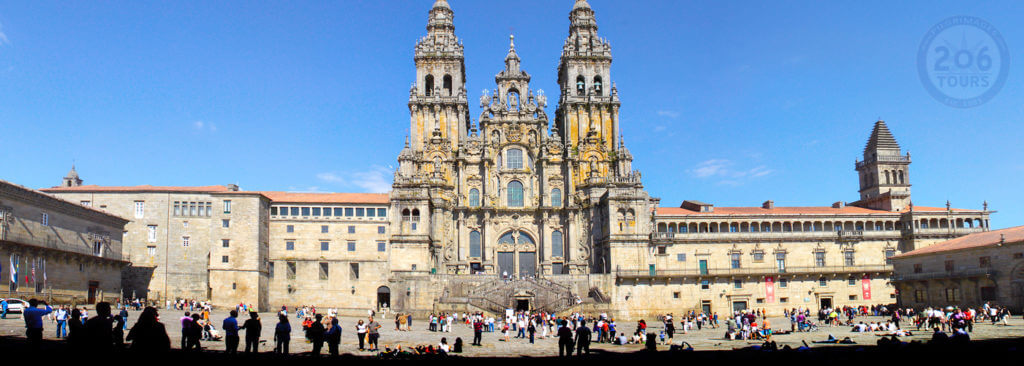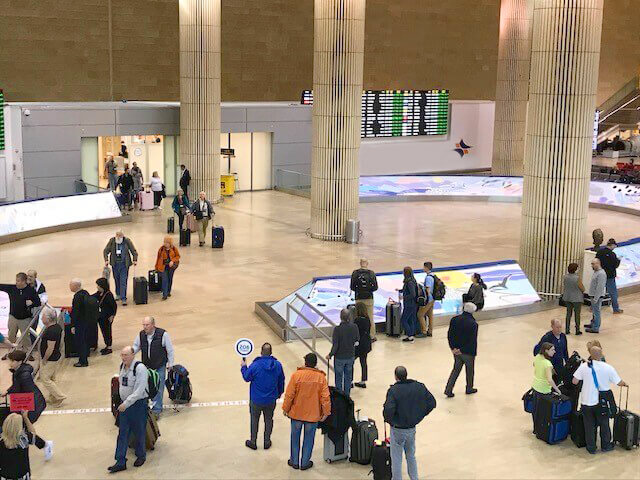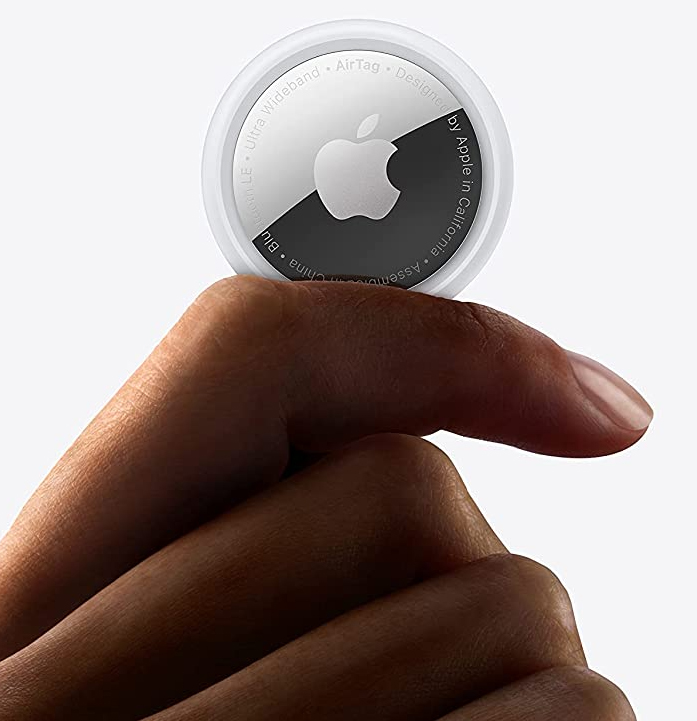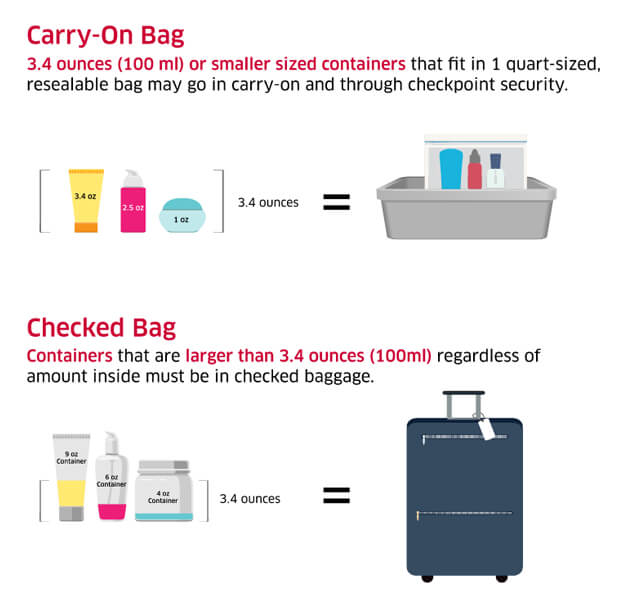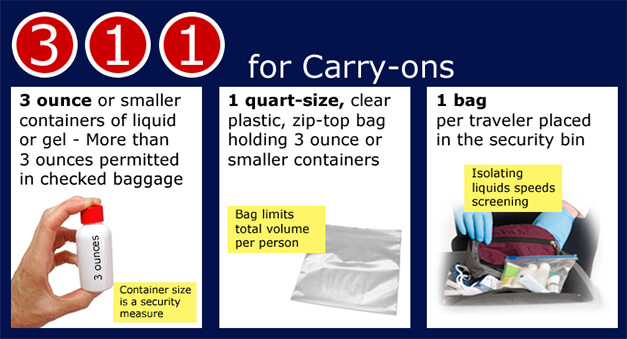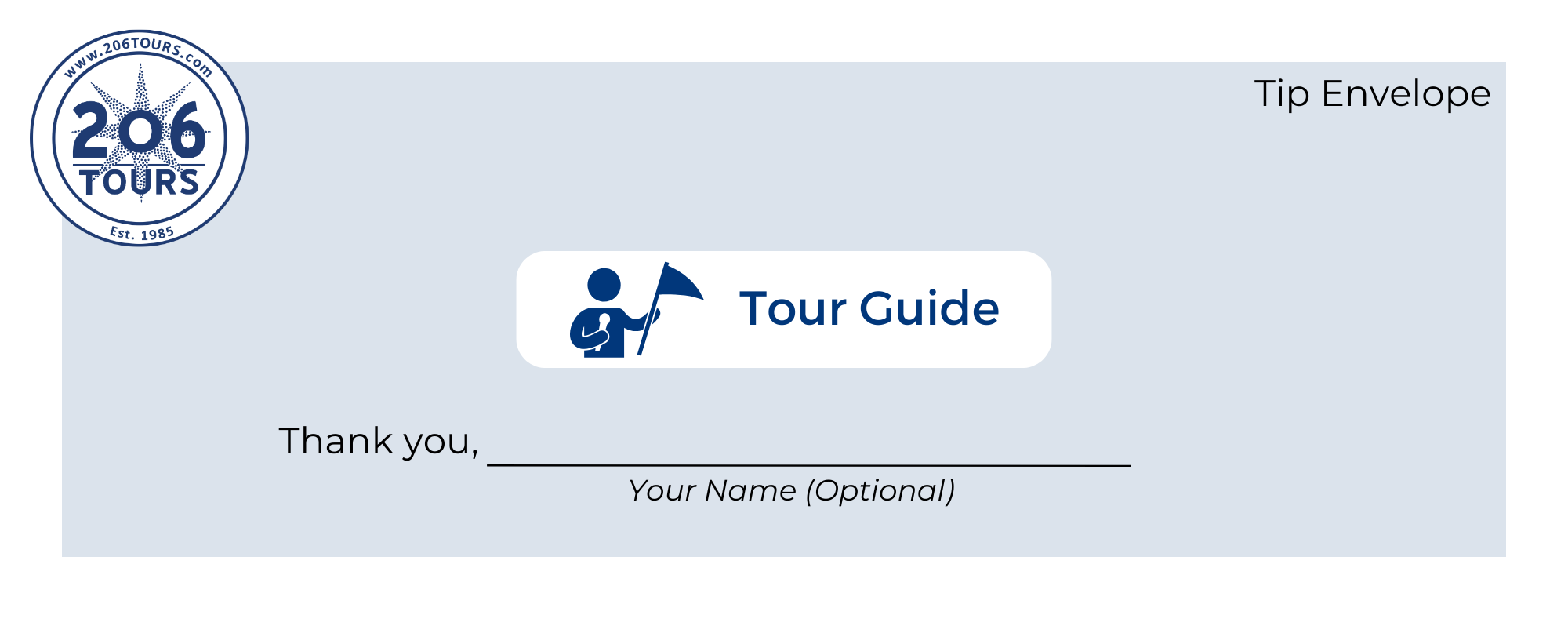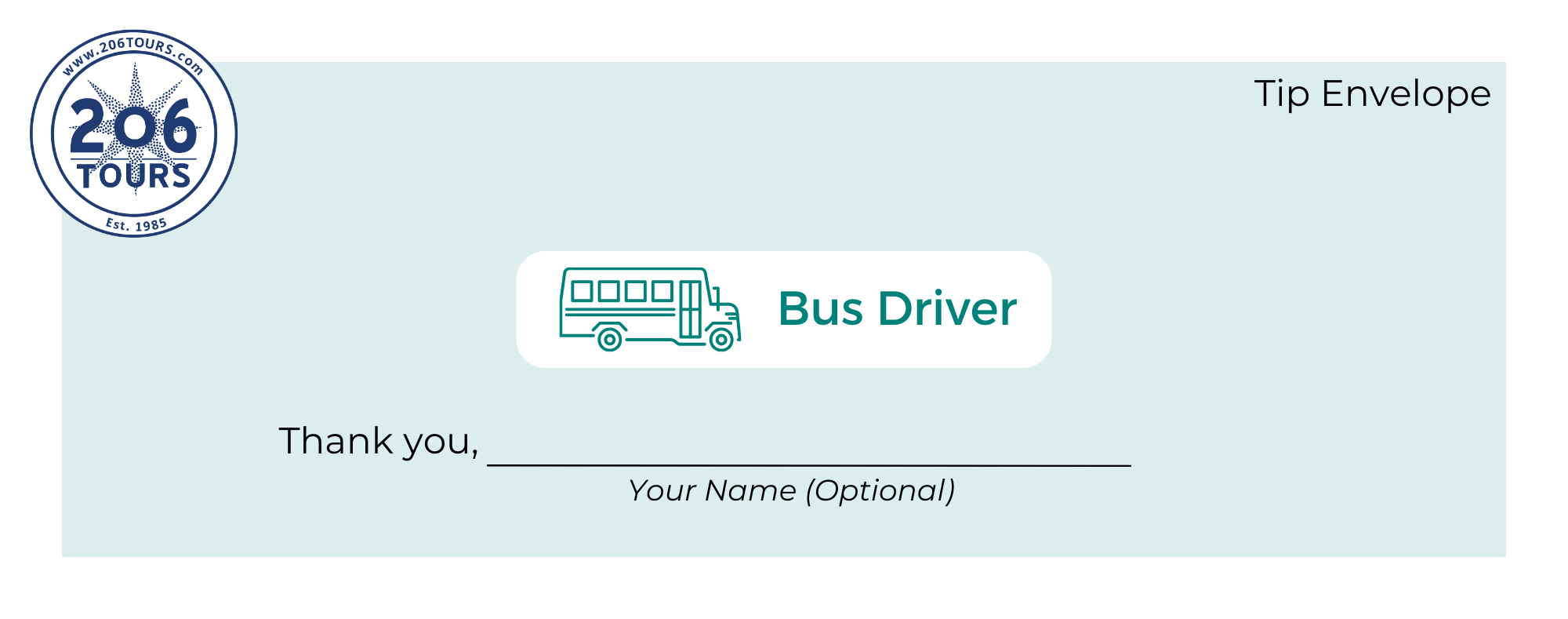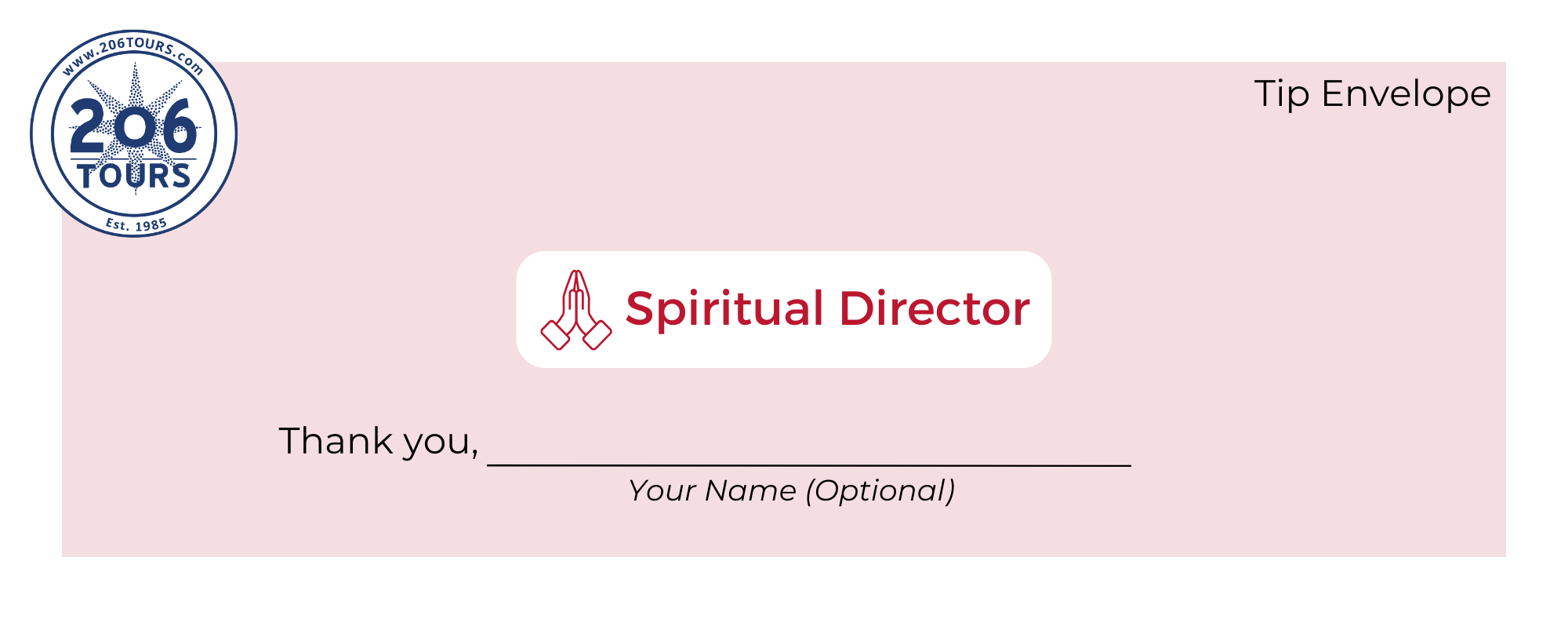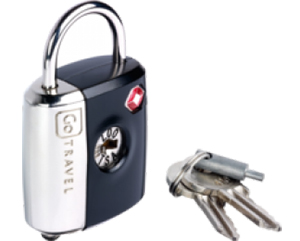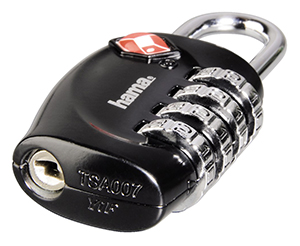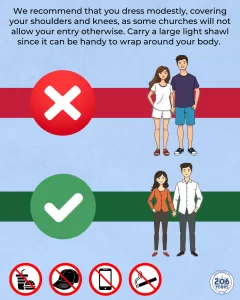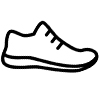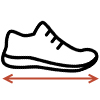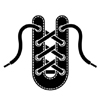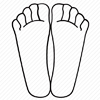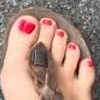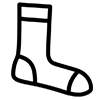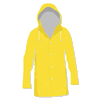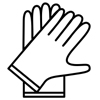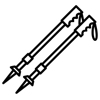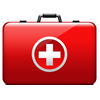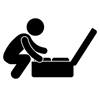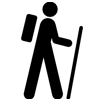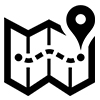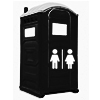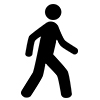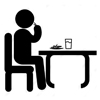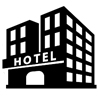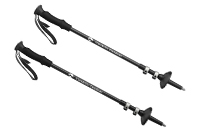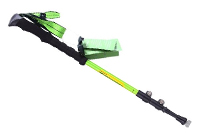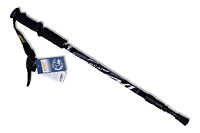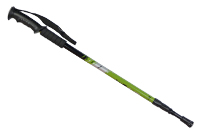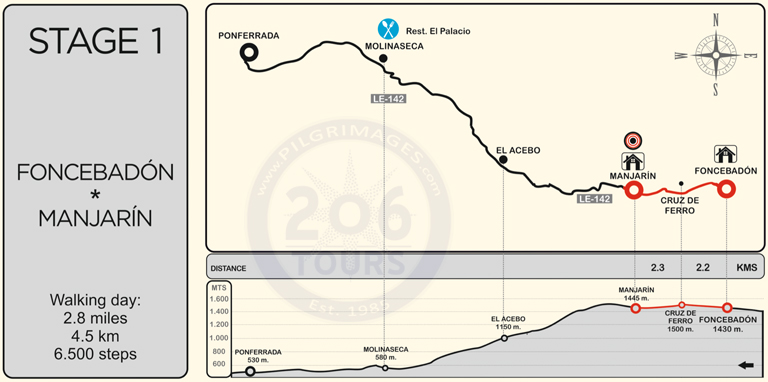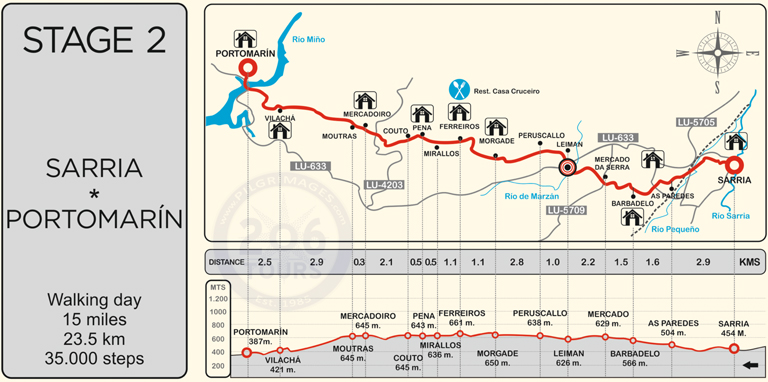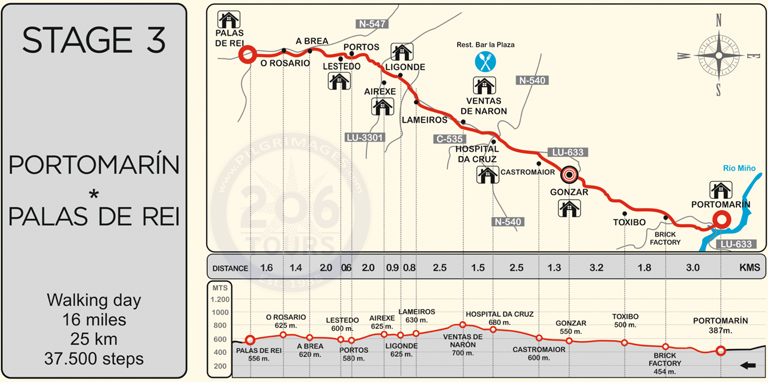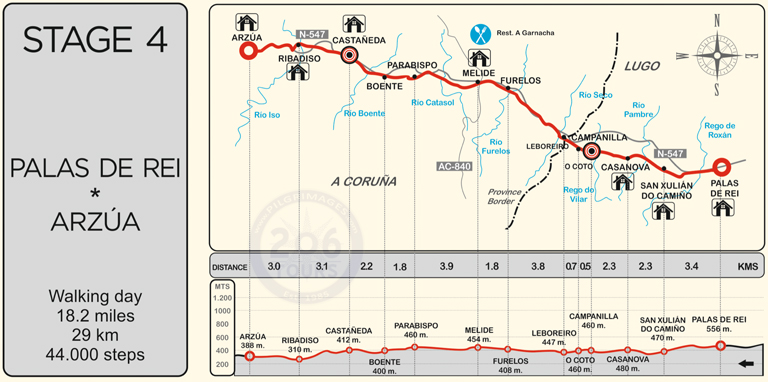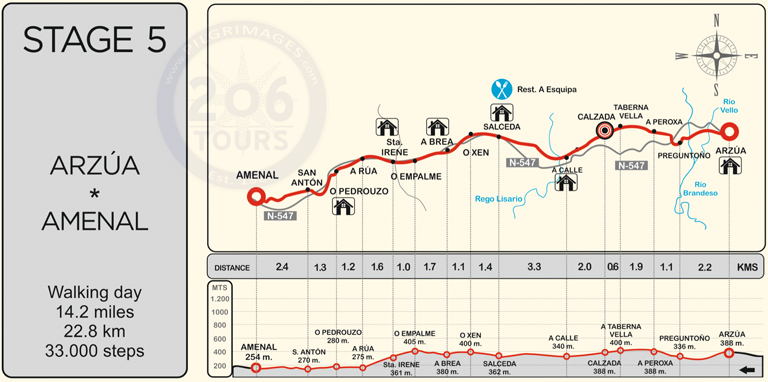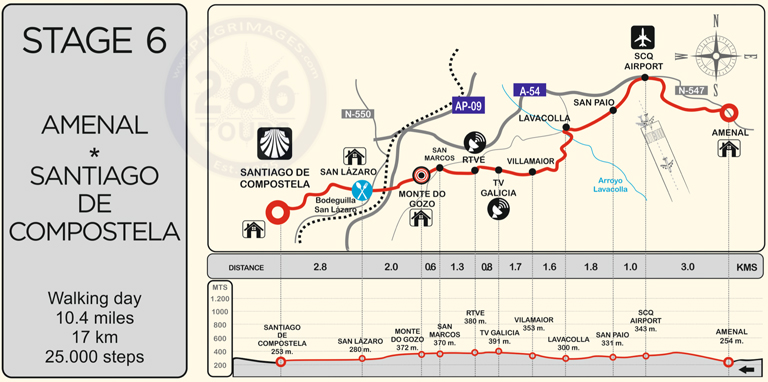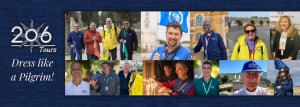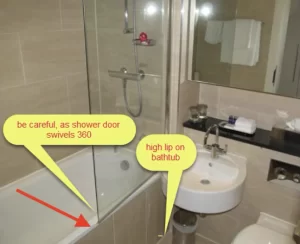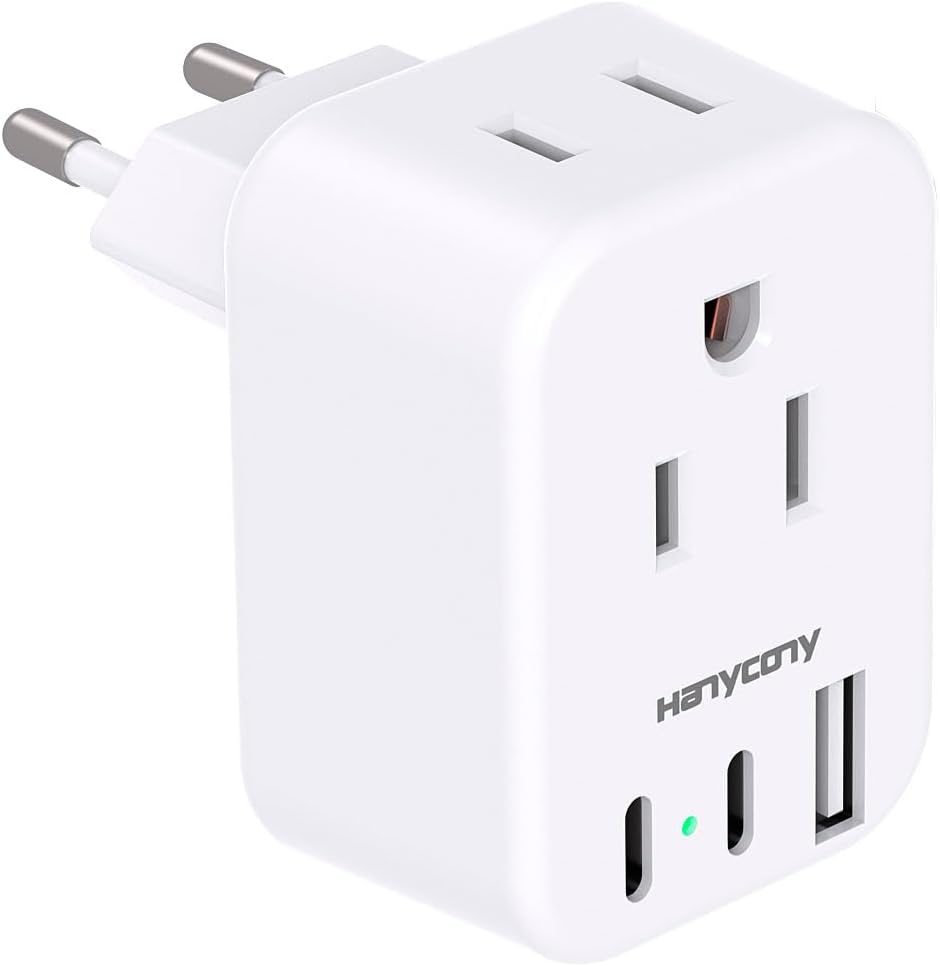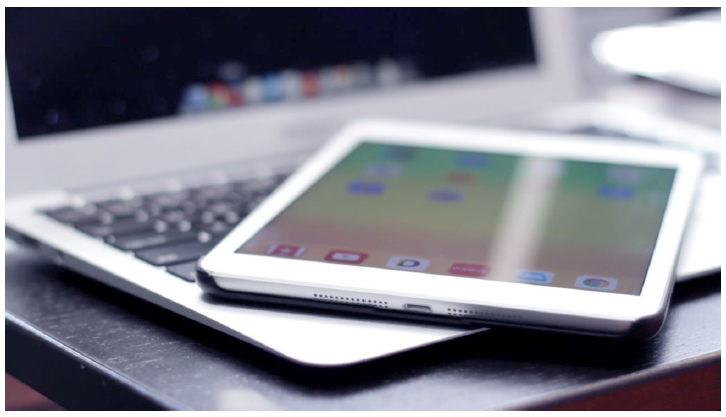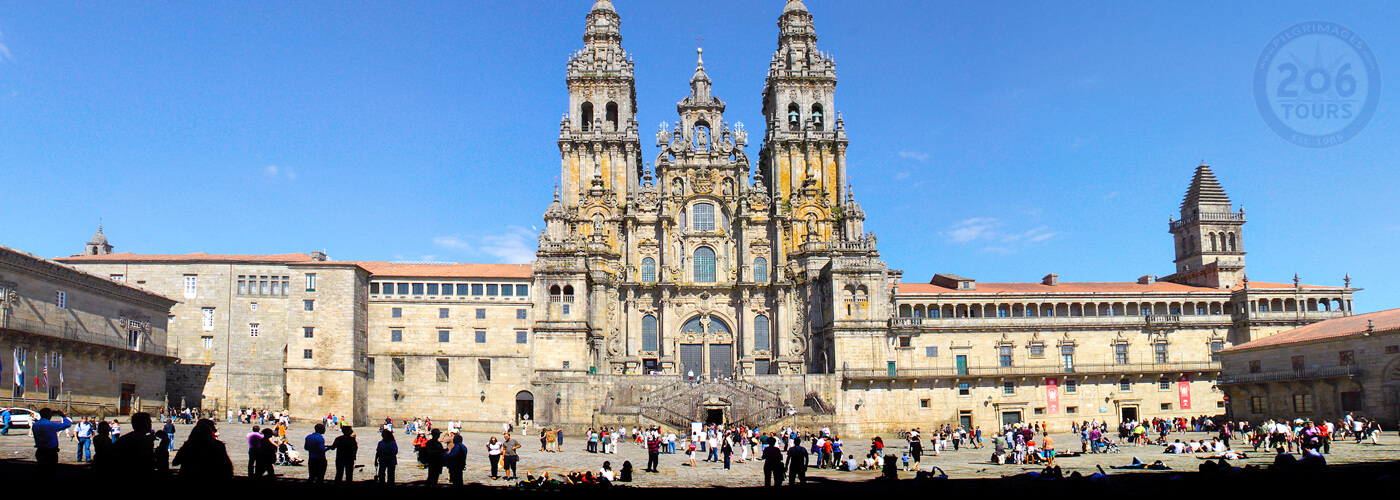
What To Know Before You Go To
El Camino to Santiago
-
About El Camino – The Way of St. James
Welcome to 206 Tours – The Way of St. James or El Camino Escorted Walking Pilgrimage
The Camino de Santiago is the most famous, and sacred, pilgrimage walk in the world. Millions of people have traveled to the ancient burial site of St. James the Apostle for over 1000 years. Open your heart and mind to be responsive to new perspectives, ideas, cultures, etc. Some of us have dreamed of making this walk for many years, imagining breathing in the beauty and awakening the soul. Finally you have the chance to experience the incredible journey. As soon as you have decided to make the El Camino pilgrimage, please work on preparing physically and spiritually, so that, before you depart, you are accustomed to walking 20 miles with not too much discomfort.
We do not include much free time for recreation, such as shopping, because we will be busy walking as well as enjoying several comprehensive tours. However, if you are tired or feel like doing only partial walk, you are free to take time and relax. If you feel you are unable to keep up with the pace of the tour, manage the terrain, or would like free time for your own interests, you are welcome to refrain from participating in any aspects of the program you desire simply inform your guide and they will get you to our next destination (no refund can be issued for any part of the tour you choose not to participate in).
One of the highlights of completing El Camino is witnessing the Botafumeiro in action at the Cathedral de Santiago. 206 Tours is committed to providing this experience for all our Camino pilgrims. That is why 206 Tours makes a generous donation to the Cathedral every time one of our Camino Pilgrimage groups are present at the Pilgrims’ Mass. This donation is what allows the Botafumeiro to operate and the experience of seeing it swinging across this magnificent Church is a memory you are certain to cherish forever.
It is important to note that the amount of walking is significant, and the terrain varies greatly throughout the tour. For this reason, we would like to offer you some recommendations, and we ask you sincerely read our tips carefully.
-
How to Prepare for your Pilgrimage
Thanks for visiting our Know Before You Go resources! Our mission at 206 Tours is to take care of all the logistics of your pilgrimage so that you can focus on preparing spiritually for a sanctifying experience! The information below details everything you need to know before going on your trip.
Do I need to know the local language?
Your tour guide will conduct the pilgrimage in English but is multilingual, so they are able to communicate to locals for you should you need any assistance.How can I prepare for my pilgrimage?
- Prepare Physically: If you are not accustomed to physical activity, begin walking 1-2 times a day. We recommend that pilgrims be able to walk up to 20 miles easily.
- Prepare Spiritually: Attend daily Mass if possible, or spend quiet time in Adoration. You can also begin (or continue) to pray the Rosary daily.
How should I raise questions/concerns during my pilgrimage?
If you need help during your pilgrimage, your guide is there to assist you at all times! Please communicate any problems, concerns, or complaints directly to your tour guide immediately so that they can best address your needs. Your guide is at your disposal to help with hotel accommodations, meals, transportation, and anything else you might need assistance with. There is little that can be done to rectify a concern once you return home, so please communicate any issues as soon as possible during the pilgrimage. Most concerns can be dealt with swiftly once brought to your guide’s attention. If you feel your tour guide does not adequately address your problem, please contact our office at sales@206tours.com -
General Info About Your Documents, Flights, Arrival & Travel
Please visit www.tsa.gov for the most up to date travel restrictions
Passports and Visas
PLEASE NOTE: A valid passport is required, and it must be valid at least 6 months after your return date (for some countries 3 months). It is the traveler’s sole responsibility to obtain, when necessary, the appropriate valid travel documents. All are advised to check with the appropriate government authority in each country visited to determine the necessary documents. At times, Hotel or Cruise Vessel May require to hold your passport. When, and if, a visa or visa waiver is required, it is your responsibility to obtain one. 206 Tours, owner, agent, or employees cannot be held liable for clients not having proper passports, visa, visa waiver, or other travel documents. Cancellations due to a lack of appropriate documents will incur usual penalties. A Passport Card is not useful for International Air Travel. Attempting to use this instead of a Passport Book will result in a denial of boarding by the airlines and entry by the legal authorities.
While most countries do not require visas for American travelers, some may. You can find out what countries require a visa by using the U.S. State Department’s destination search tool:
Enter your country into the search bar. Then, on the country’s information page, you will find entry, exit, and visa requirements. You will also find travel advisories and a link to the country’s embassy.
Emergency Telephone Numbers in Spain:
Emergency Police: 112
Ambulance/Medical: 122
Emergency/Fire: 112European General Emergency Code:
112Airport Check-In
Walk over to the designated airline check-in counter. You must personally present your passport and your own luggage.
The agent will locate your reservation, give you the boarding pass and luggage slip is being sent via same flights.
(Unlike domestic flights you will not be able to print your boarding passes for international flights at home)
Ensure that your luggage is checked through all the way through to your final destination.
This will eliminate the need to claim your luggage between flights and re-check in before your connecting flight.Flight Changes/ Delays/ Cancellations: If your flight is experiencing a long delay, or a cancellation, do not panic, go to the airline customer service counter, or contact the airline, ask to be rebooked to another flight/airline, ask for meals or a hotel room.
Be Persistent. Speak with the kindest tone, but keep trying, do not just take “no” for an answer. Airlines will rebook you on the next flight to your final destination. Be Nice! Never yell or be rude to staff, as they are going through a lot and it is not their fault. You can take it out on CEO’s by writing a letter to particular airline’ customer service.
How early should I arrive at the airport?
- Domestic Travel: Arrive at least two (2) hours prior to flight
- International Travel: Arrive at least three (3) hours prior to flight
Airline Connections
Where is my flight itinerary?
206 Tours provides you with your flight itinerary via email . This itinerary shows the airline, flight number, departure and arrival times, and seat/meal information. It is recommended to keep the printed copy with you or download the itinerary to your smartphone for easy reference.How are my flights arranged?
206 Tours books airline reservations in accordance with TSA rules, regulations & routings. We do our utmost to provide the most convenient flight schedule available. Pilgrims will be traveling independently on all flights.Why does my plane reservation say one airline, but the plane reads another?
Many airlines participate in special agreements to share aircrafts. For example, your ticket may show United Airlines as your carrier even though you are actually seated on a Lufthansa plane. These are called “codeshare” flights, and if applicable it will be shown on your itinerary in the following way: “Flight operated by (airline).”Who decides the connection time at airports?
The airlines determine the minimum connection time required to transfer from one gate to another for a connecting flight. 206 Tours does our best to provide ample connection time based on available flights and in accordance with our scheduled group transfers.Flight Delays & Arrival Transfers
What if my flight is delayed or canceled?
If your flight is delayed or canceled, you must work DIRECTLY with the airline agents at the airport to arrange for alternate flights. Once you check-in for your flights, 206 Tours can no longer make any adjustments to your flight itinerary. After check-in, changes can only be made by the airlines.In this scenario, please be persistent with the airline agent you are working with to rebook. Keep in mind that the situation is not the agent’s fault and try your best to remain calm and courteous to receive speedy assistance. Keep in mind that the airlines are not required to offer reimbursement for overnight stays when delays/cancellations occur due to weather. If you find that you are unable to receive adequate assistance from airline personnel, please contact the 206 Tours emergency line and we will do all we can to assist you remotely.
TIP: Once your airline has rebooked you, text/call your guide to advise them of your new arrival time so that transfer arrangements can be adjusted. Your guide’s phone number can be found in the digital confirmation email sent to you by your account manager.
What if I miss the group transfer upon arrival?
If you miss the group transfer to the hotel due to a flight delay, missed connection, or another reason, you may:- Take a taxi to the hotel at your own expense.
- Contact your guide and ask for 206 Tours to arrange a private transfer at an additional cost.
*Be sure to obtain a receipt of your transportation. Upon returning home, you may wish to seek reimbursement for the cost if the reason for missing the transfer was due to airline problems.
What if I want to make a last-minute change to my ticket?
If you would like to make changes to your airline ticket once it has already been issued, you MUST work DIRECTLY with the airlines. You will incur additional costs (a minimum of $400 per person) for such changes.Arrival Procedure
What do I do when my flight lands?
After deplaning, you will clear immigration and then proceed to baggage claim. Pay attention to the monitors above the conveyor belts in baggage claim. The conveyor that your bags will come out on will have monitors above it displaying your flight #. Once you collect your luggage, you will exit the baggage claim area through customs and into the arrivals hall/lounge. There, you will meet your guide/driver who will have a 206 Tours sign.Look for the “206 Tours” Sign!
In the arrivals hall, you will be greeted by a 206 Tours representative holding a “206 Tours” sign. They will escort you to your hotel where you will check-in and have time to refresh before meeting the rest of the group later in the day.TIP: If you do not see your guide/driver, look in that surrounding area (as they may have stepped back to assist another pilgrim). If you still cannot find them, contact your guide by utilizing the phone number provided in your final confirmation email.
Lost Luggage
If your luggage is missing, proceed to the baggage office to complete a missing luggage form. Please make sure to save all of the paperwork and tracking information given to you by the airline. Upon locating your baggage, the airlines will deliver the luggage to your hotel. It is very important that you provide them with the correct addresses of your hotels, as well as the dates that you will be staying at each of them (listed in your final confirmation email). You may also provide the airline with the phone number of your guide. If your baggage is delayed for more than 24 hours, and you purchased insurance, you may submit a claim upon your return to the US. This is only applicable to passengers that purchased travel insurance through 206 Tours.
*206 Tours strongly suggests that pilgrims carry one change of clothes in their carry-on luggage and their daily medications in their personal item.Apple AirTags
As you plan your trip, consider including Apple AirTags on your packing checklist. These compact, coin-sized devices act as personal tracking systems, offering a reliable solution to keep tabs on your luggage. Leveraging Apple’s vast Find My network, AirTags allow you to trace your belongings right from your iPhone, iPad, or Mac. They’re straightforward to use: simply attach an AirTag to your bag, and voila, your luggage is now traceable on a global scale. The device’s precision finding feature also provides visual and haptic feedback to guide you right to your misplaced or lost item, a feature especially useful in busy airports or hotels.
If you choose to utilize this tool, it’s essential to familiarize yourself with the functionality and limitations of the AirTags before you embark on your journey. While they offer an innovative way to track your belongings, they rely on being in range of devices in the Find My network to relay their location. This means their effectiveness could be limited in areas with low Apple device density or poor internet connectivity. Also, remember that AirTags are designed for tracking objects, not people or pets. A built-in anti-stalking feature notifies individuals if an unknown AirTag is moving with them, so using AirTags for unapproved purposes could lead to unintended alerts. With responsible use, Apple AirTags can add a layer of security and peace of mind to your travel experience.
If you do not have an apple device, consider one of these other tracking devices. These devices are also good to put on your carry-on, personal item, etc. in case you lose them.
How to Overcome Jet Lag
Traveling through time zones affects people differently. Some people get incredibly exhausted from the long flight and time change. Here are some suggestions that may help you beat jet lag:
- Pack for your trip at least two days ahead of time.
- Make sure to go to bed early the night prior to travel.
- Hydrate! Drink more water than usual to avoid dehydration on the flight. Being seated for long periods of time can be very hard on the body and can cause poor circulation and bloating. Hydration is key to preventing this.
- Try to sleep on the plane!
- Think in “Local Time” – reset your watch to the local time of your destination as soon as you board the flight. It may help to do this one day before travel, or even to slowly transition to local time a couple of days before travel if your schedule allows it.
- Stay busy – When you arrive at your destination, try to stay busy and go to bed at an appropriate time that night. Pacing is key!
- Eat fresh, healthy foods like vegetables, fruits, and protein to keep you alert. Heavy, greasy, or high-carb meals will make you more tired.
- Exercise – take a twenty-minute walk in the morning, stretch before getting on the plane, and get up and walk every now and then during the flight. Moving gets your blood flowing and allows your body to adjust to time changes easier. Make sure to keep moving when you get to your destination, as this will help you stay awake until nighttime.
- On the day of return, get out of bed earlier than normal, hydrate, and try to get sleep on the flight home. Reset your watch and start thinking in the local time of your home.
Baggage Regulations
How much luggage can I bring?
Your Pilgrimage Includes:- One (1) piece of checked luggage
- One (1) carry-on bag
- One (1) personal item
Checked luggage
The checked bag is the larger bag that contains the bulk of your belongings. Upon checking in at the airport, this is the bag that you give to the agent that gets stored underneath the plane. Your checked bag will be weighed at the counter, so make sure you weigh it at home and ensure it does not exceed the allowed weight. You can do this by weighing yourself alone, then weighing yourself while holding your bag, and subtracting the difference. Because your checked luggage will not be with you on the flight and could potentially get lost, do not pack daily medications or essential items (wallet, passport, etc.) in your checked bag.
Size Allowance:
- Length + Width + Height cannot exceed 62 inches/158cm
- Economy Class: One (1) Checked Bag at 50 lbs/23kg
- Business Class: Two (2) Checked Bags at 75 lbs/32kg
TIP: If you cannot pick it up, it is too heavy!
Carry-on Luggage
A carry-on bag is the bag you bring on the plane with you, which must fit in the overhead compartments. Airlines are strict about the size of a carry-on bag. If it is too large, you will be subject to fees. Always take vital personal possessions with you at all times, such as your passport, wallet, and medications. Do not pack these or other items that you cannot be without in your carry-on luggage, as it is possible that the airline may ask you to check your carry-on if they run out of overhead space.
Size Allowance:
- One (1) bag: Length + Width + Height cannot exceed 42 inches/106 cm
- The bag may not exceed 17 lbs (8kg)
TIP: Our 206 Tours bag meets the measurement requirements. Carrying one of our bags will also make it easy for the guide and/or driver to spot you in the arrivals hall.
Personal Item
- One (1) personal item is permitted in addition to your carry-on bag – this can be a laptop, iPad, book, small purse, etc. If you are unsure if your personal item fits the criteria, look up your airline’s particular guidelines for personal items.
Carry-on Bags: 3 – 1 – 1 Liquids Rule
Liquids, gels, aerosols, creams and pastes must be:
3 – Four OZ bottle or less
1 – Quart-sized, clear, plastic, zip-top bag
1 – Bag per passenger screened on its ownRemember, you can put liquids of any size in your checked baggage
Permitted:
Reasonable quantities exceeding 3 OZ are allowed of the following:
- Baby formula, breast milk, and juice for infants and toddlers
- All prescription and over-the-counter medications (liquids, gels, and aerosols) including eye drops and saline solution for medical purposes
- Liquids including water, juice, or liquid nutrition or gels for passengers with a disability or medical condition (a doctor’s note is required)
- Items used to augment the body for medical/cosmetic reasons such as mastectomy products, prosthetic breasts, bras containing gels, or other liquids
- Gels or frozen liquids needed to cool medically related items, such as medicines, used by persons with disabilities or medical conditions
Declare the above items for inspection at the checkpoint. TSA officers may need to open them for additional screening. Any liquid, gel or aerosol, such as coffee or soda, purchased in the secure area beyond the security checkpoint is allowed aboard your plane. If you have a layover and are re-screened at your connecting airport, the above rules will be applied.
Personal Items Carry-on Checked All Make-up – You are allowed to carry any liquid/gel/cream makeup item provided that the container is up to 3 oz., as per the 3-1-1 rule. *mascara, chapstick, lip gloss, etc are all considered liquids. Yes Yes Safety Razors – includes disposable razors Yes Yes Saline Solution – You are allowed to carry up to 3 oz., as per the 3-1-1 rule. Volumes greater must be declared to the Security Officer. Yes Yes Tweezers, Scissors, Nail Clippers – plastic or metal with blunt tips or metal with pointed tips and blades shorter than four inches in length. Yes Yes Shampoos & Conditioners – must be in 3 oz. or smaller container inside your 1 qt Ziploc bag Yes Yes Toothpaste – 3 oz. or smaller container inside your 1 qt Ziploc bag Yes Yes Umbrellas– allowed in Carry-On baggage once they have been inspected to ensure that prohibited items are not concealed. Yes Yes Walking Canes – allowed in Carry-On baggage once they have been inspected to ensure that prohibited items are not concealed. Yes Yes Electronics Carry-on Checked Camera Equipment – the Checked Baggage Screening Equipment will damage undeveloped film in camera equipment. We recommend that you pack undeveloped film in your Carry-On baggage. Yes Yes Laptops, Smartphones & I-Pads Yes Yes Food & Drinks Carry-on Checked Beverages – from Home or purchased before reaching the Security Checkpoint in containers LARGER than 3 oz. No Yes Beverages – from Home or purchased before reaching the Security Checkpoint in a 3 oz. or smaller container and in your quart-size bag Yes Yes Beverages – purchased after Security Screening Yes Yes Medication, Baby Formula/Food, Breast Milk, & Juice – allowed in reasonable quantities exceeding 3 oz and are not required to be in the zip-top bag. Declare these items for inspection at the checkpoint Yes Yes Canned or Jarred Goods – such as soup, sauces, peanut butter, fruits, vegetables and jellies (3 oz. or smaller container) Yes Yes Cheese – in pressurized containers (3 oz. or smaller container) Yes Yes Duty-Free Alcohol and other items (some restrictions apply) Yes Yes -
Currency & Money
Currency
The Euro (EUR) is the currency of Spain, though the US dollar is widely accepted.
For most current exchange rates please visit www.xe.com. This website provides “pure” exchange rates. Pure rates do not include bank fees.
Money
Where can I exchange money?
- Your Bank – Visit your bank before traveling for the best exchange rate
- Airports – there will be a convenience fee
- Major banks at the destination – there will be a small exchange fee
- ATM Machine – while in Spain, an ATM machine is the most practical and cost-effective option. Utilizing your ATM card or debit card, you can also get cash advances on your credit card at an ATM, but there will be high fees.
How do ATM machines work in Europe?
ATM machines can be found at most bank branches, post offices, train stations, airports, shopping centers, etc. and are accessible 24 hours a day. Most banks charge a fee when you withdraw money, especially if it is from the network of another bank. You should ask your bank for information about where you can use your card and what fees are charged for withdrawing money. Most US banks apply a $2.00-$5.00 international ATM fee in addition to the ATM’s fee. Your bank will utilize an exchange rate that is a couple percent above the “true” exchange rate. Be sure to find out your daily withdrawal limit before you depart. If you have any questions about your ATM card, check with your bank before your departure. Ensure you know how to contact them if you encounter problems using your card. Use your card before you leave home and again shortly after arrival, even if you do not need the money, solely to verify that everything works.You can also get cash advances on your credit card at an ATM. Credit card companies try to protect themselves from theft by limiting the funds someone can withdraw outside their home country, so call your credit card company before you leave home. Keep in mind that you’ll pay interest from the moment of your withdrawal, even if you pay your monthly bills on time.
Can I use my credit card in Spain?
Yes! We highly recommend using your credit card as it offers convenience, reasonable exchange rates, and security (you can cancel them if they are lost!). Visa and Mastercard are the best options, as they are accepted in most stores and restaurants. American Express and Discover are not widely accepted in Europe. Your guide can also advise you where the ATM machines with the lowest fees are located. Keep in mind that certain purchases (such as in Church gift shops, tipping on your own at restaurants, etc.) require cash.IMPORTANT: Before you leave, inform your bank and credit card companies that you will be traveling in Spain so that they do not flag, block, or suspend your account due to international transactions.
NOTE: For increased security, European banks now issue debit and credit cards that carry an embedded chip. As a part of their anti-fraud measures, you are seldom asked to give a store/restaurant employee your card for them to swipe. Instead, if you are at a restaurant on your own, your waiter will bring a portable card reader to your table with the amount of your bill already entered. You cannot add a tip to the total, so leave a small tip in cash instead. Your card is swiped, and you will be asked to OK the total and enter a PIN. The PIN for this is not the cash back PIN. If you have an older US credit/debit card without a chip, you may not have a PIN. In the case that you do not have a PIN or forget it, just hit the OK again with no PIN entered. It usually works.
How Much Cash-Money Should I Bring?
This is totally subjective based on how much you’d like to spend on souvenirs and meals not included, usually lunch is the only meal that is not included. We generally recommend you bring at least 200 EUR per person or that you get it upon arrival. Cash machines are available throughout your itinerary, and most places accept credit cards.TIP: Try to get about 10 – 15 Euros in small bills to light a candle, or bathroom stops.
How does tipping work?
Tips are an important part of earnings for your guides and bus drivers. While tips for provided meals, local guides, porters, etc. are included, tips to your 206 Tours guide and driver are not. Tips to your guide and driver are up to your discretion. Please use the tip envelopes provided with your travel documents.When do I give the guide/driver their tip envelopes?
We suggest you tip the tour guide and bus driver the day prior to your return. We provide labeled tip envelopes within your final documents package.How much should I give?
Tip according to your discretion and satisfaction level. Tipping in local currency is preferred. We recommend an amount per person/per day below.Do I tip the spiritual director?
This is not required, but some pilgrims choose to give a small gift or donation.Tips
Although you should tip according to your satisfaction level, the following amounts are recommended. The tip envelopes are included in your final documents package.
Tour guide in Spain – €8.00 per person per day
Local currency is preferredBus Driver in Spain – €4.00 per person per day
Local currency is preferredSpiritual Director/ Your Priest – A gift or donation to
the spiritual director is at your own discretion.Tipping in Spain:
We recommend bringing $50. in small bills, for incidentals such as restroom facilities, candles in churches, and church donations.
Almost all restaurants include tax and a 15% service charge (service compris) in their prices. If a meal or service has been particularly good, leaving another euro (or 2) is customary, as is leaving the waiter the small change from your bill if you pay in cash. If a service charge is not included, a 10-15% tip is appropriate. You do not have to worry about this for included meals on your pilgrimage, but it is good to know for when you eat on your own.
In hotels, tips to the porters and chambermaids are included. If you are using a taxi on your own, drivers should be given a tip of 10-15% of the metered fare.
If your group has completely free days and the guide only sees you for a couple of hours or during dinner time, it is really up to you what you want to tip them. Normally most clients calculate a total amount of tips for the guide and driver for total days serviced. Keep in mind that when the tour guide works less hours one day, it normally compensates for the days with longer hours.
U.S. Customs
U.S. citizens who have been to Europe for more than two days may return to the United States with up to $800 worth of merchandise duty-free. For those who wish to bring more home with them, a flat rate of 3% duty is levied on the next $1,000 worth of purchases. It’s a good idea to retain the receipts from your purchases should they be requested by a customs inspector upon your return to the United States. For more details please visit the U.S. Customs and Border Protection website http://www.cbp.gov/xp/cgov/travel.
Value Added Tax (VAT) Refund
There is a 21% value added tax on most goods and services in Spain. At retail stores, this tax is always already included in the price. Upon making a purchase of 90,16 EUR or more at a gift store that has an agreement with the VAT authorities, you should acquire a refund document at the store and have it stamped. This refund offered to non-European citizens is called détaxe.You will be eligible, upon presenting the form and the item at the airport, for a 21% refund at the airport prior to departure. You must be over 18 years old and you must present a passport to receive the refund. You never really get the full 21% back, but you can come close.Tourist services (such as hotel accommodations and meals taken in hotels) paid with foreign currency are exempt from VAT tax.
How to Get Your VAT Refund:
After you spend the required minimum amount of 90,16 EUR at a participating retailer, ask for your détaxe papers. If you’re considering a major purchase, ask the store policy before you get too involved or be willing to waive your right to the refund. Fill out the forms before you arrive at the airport for departure to the U.S. All refunds are processed at the final point of departure from the E.U., so if you’re going to another E.U. country, you don’t apply for the refund in Spain. Be sure to have the forms stamped at the airport customs desks. The customs official may ask to see your purchases, so it’s best to pack them in your carry-on bag. Mail the stamped forms at the airport (the store provides an envelope) and the refund process has begun. Find additional information on the VAT refund in Spain here.
TIP: Mark the paperwork to request that your refund be applied to your credit card, so you aren’t stuck with a check in Euros. Even if you made the purchase in cash, you can still get the refund on a credit card. This ensures the best rate of exchange. You can get cash in some airports, but if you don’t take the cash in Euros, you’ll lose money on the transaction.
-
Luggage & What to Pack
What to Pack
Your pilgrimage includes one (1) piece of checked luggage, and one (1) carry-on. International air carriers are becoming stricter about the size and weight of baggage and carry-on luggage. please limit the size of your hand luggage to 17x14x8 in. (43x36x20 cm) for easy storage on the motor coach. Porterage for one suitcase on tour is included in the tour price. The checked piece of luggage should have dimensions not exceeding 62 inches in overall (62inches: length+width+height) and weight not exceeding 50 lbs (23 kg).
Carry all documents and money on your person but not all in the same place to limit the inconvenience in case of loss; do not keep money, important documents, medicines or jewelry in your suitcase; We recommend a money belt worn inside your clothes, while touring. On departure from your hotel, remember to double check that you have your money belt with you, and that you have collected any items left in the hotel safe. Please, at all times, be as vigilant as you would be in any major city, especially in crowded places. Never leave your hand luggage unattended or out of sight in public areas, including airports, hotel lobbies or dining rooms.
Be sure to keep ALL medications in your carry-on bag during your trip in case your suit case should be lost. Keep a separate list of important numbers, i.e. passport, traveler’s checks, and credit cards, in your luggage, together with photocopies of relevant pages of your passport/visas. Keep a separate copy i.e. passport, flight schedule, credit cards, in your luggage, The same common-sense rules of safety and security apply here as to anywhere else. Avoid excessive displays of jewelry or cash (only carry sufficient for daily needs). Room Safes may be used at your own discretion. Make certain that any valuables are insured against theft. Avoid exploration on your own of unfamiliar streets or areas Be cautious if people approach you begging.
Luggage Locks
The more secure your personal items are, the better! TSA suggests you lock your luggage before you embark, and when you are flying home. In order to ensure the safe transportation of travelers, TSA screens all checked, and carry-on, baggage before it is permitted to be brought onboard. You can purchase locks for your bags, however, if they are “screened”, you run the risk of them being cut open and no longer usable. However, there are TSA Recognized Locks – which allow TSA officials to use tools for opening and re-locking your baggage. Below are recommended brands:
Safe Skies: www.safeskieslocks.com
Travel Sentry: www.travelsentry.orgSuggested Clothing:
Here are some highlights and tips we prepared these tips for you to consider prior to your Camino to Santiago. Once you arrive Madrid, your guide will give an extensive presentation on what you can expect. Feel free to ask any questions during this orientation meeting. There will also be a meeting each evening as to what you can expect the following day.
Upon arrival your guide will have for you as follows:
~ Pilgrims Passport
~ Pilgrims Map
~ El Camino shell (you will wear around your neck)
~ Walking Sticks (they are on the bus for you to use and are optional)Every evening you will have a meeting with your guide regarding next walking day.
Shoes Many people will give you advice, but, they have probably not walked 15 miles per day on the Way of St James in pouring rain. Once you book your Way of St James Walking Pilgrimage you should work on two things: start walking and start looking at shoe options. If you don’t have proper shoes, you will be miserable. Invest time and try out as many shoes as you need to. Wear them in for a few weeks. All shoes must be broken in before walking the Camino. The right shoes/boots matter. They should be waterproof (Goretex) and flexible. It is not a good idea to wear boots that are made for climbing as they are too hard and too high (Boots have changed. They are not as heavy and, or, as stiff as they were just few years ago). Of course, one can walk El Camino in running shoes, or if you want to do major penance you can walk in high heels or even barefoot. Actually, barefoot is how pilgrims used to walk the Camino long ago. In the end, the shoes you get is an individual preference. We all have differing foot issues, and it is virtually impossible to say what works for most would work for all.
Here are some shoe recommendations from Camino Pilgrims:
- Merrell Moab 3 low cut boot
- Meindl Rapide GTX (trail shoes) with a Superfeet Trail insole
- Salomon XA Pro 3D
- Altra Olympus for the wide Toe
- La Sportiva Raptor II Mid Wide GTX low boots
- Hoka trail runners
- The Meindl Rapide GTX wide fit
- Jack Wolfskin Vojo 3 mid rise
Shoe Size The size is important. Although your foot cannot move inside the shoe too much, but shoes cannot be tight either or you will get blisters and because of many downhills you may lose your toe nais may have a serious problem. We recommend you try as many hiking shoes as possible until you find the most comfortable pair. Each individual is different, but almost all feet will swell after miles of walking, so consider getting two pairs of shoes, first pair 1/2 size larger than what your normal shoe size is, for first half and second one 1 full size larger for last few days, just in case.
Lace up Learn how to lace up shoes, there are many ways.
Feet As a pilgrim, your feet are your most important asset. Take good care of them. Walking 12 -20 miles per day, up and down some serious hills is not a walk in the park. Training and tips must be considered. If you know pilgrims who have walked the Camino to Santiago, you have most likely heard that blisters can be a huge problem. Lancing and draining blisters is not how you want to spend your evenings while on the Camino.
Tips to Help Prevent Blisters:
- Vaseline: Bring a small of medium tub of Vaseline. Vaseline your feet well every morning (you cannot use too much).
- Toe-separated Socks: The Injinji’s toe socks (or similar) are designed for hikers. There are plenty of selections but choose a pair that is not too thick. When you put them on, make sure there are no wrinkles as that could cause a nasty blister later on.
- Add a 2nd pair of socks (over toe separated socks). It is recommended to use hiking socks.
- Tape your feet in vulnerable areas. Consider using jelly tapes in between your toes.
If you do get blisters, your 206 Tours guide will have all the supplies and equipment necessary to help you.
You can make a Molefoam doughnut hole around the blister (surrounding foam to keep your sock from rubbing and irritating the area) than add a layer of Moleskin or tape over the area.
Search on Google on how to prepare your feet for a marathon walk or extreme hiking. Everyone is different and some are fine by doing absolutely nothing, while others suffer even as they are trying different methods. Putting some adhesive tape around your big toe, on your pinky toes and the ones next to it. Plus, vaseline will do your feet a lot of good.
Toe Nails Cut your toe nails as short as possible. You do not want your toenails hitting the front of your shoes when walking downhill, or you may lose them.
Socks Bring extra pairs of socks. Do not get 100% cotton. Instead choose socks for waterproof shoes which will allow your feet to breathe. Consider toe-separated socks designed for hikers. Plus, a 2nd pair of hiking socks. Or get liner socks and then put trekking socks over them. If your socks get wet, change them.
Raincoat Pancho. Invest in good one. This is very important because it rains a lot in the areas and mountains in Galicia where we are walking. It can rain the entire day. Since most raincoats that you find in stores are only meant to withstand 30 minutes of rain, invest in a higher quality, waterproof raincoat with a good hood.
Gloves We know it sounds crazy as you always thought that Spain has Mediterranean weather, but mornings in Galicia’s mountains can get chilly. It is important to protect your hands with gloves. Also, when it rains, wearing gloves can help as well as if you need to handle rock/wood on terrain.
Hat Bring a hat to protect your face from sun.
Walking poles We have them for you, unless you want to bring your own. Some people don’t like walking with poles, while others do. We believe that walking with poles can help to take pressure of your joints and feet.
Clothing Consider two clothing options: one for walking and the other for evening. Layering is the best approach. Although you might be going in the summer months, remember you will be walking in high altitude.
First Aid Kit Our guide has the essentials and there are plenty of pharmacies along the way. Do bring “Compeed” or other treatment for blisters, as well as your other essential medication(s).
Packing Everything that you will read on the internet in regards to packing was written for those people who will have to carry everything on their backs. That will not be the case with 206 Tours! Your load will be very light, because your driver will transport your luggage from one place to another and all you will have to consider is bringing a 206 Tours backpack with a bottle for water, which you can refill all along the way, extra pair of socks, hand sanitizer, and what you feel will be your essentials until the end of the segment. If you forget anything, do not worry. There is always an opportunity to purchase it in the next town. Your guide will help you.
Pace It’s Not a Race! Listen to your body. It will give you a feedback as to what you can and cannot manage. We usually begin each day with breakfast and Mass, then we are off as a group, but each person walks at their own pace. Best to start off slow and build up. Take regular breaks and stop when needed. There is plenty of time and our guides and drivers will be there waiting for you at the checkpoints. Don’t worry about how fellow pilgrims are progressing or try to follow anyone. That is why we have our guide and driver. It is recommended that you walk some segments alone so that you can enjoy the walk and talk to God. That is what El Camino is all about. We do not recommend any listening devices. Listen to the birds, rain, leaves moving in the wind and streams flowing. People from all over the world may pass you or want to engage in conversation. That is fine in limited periods. Find your own pace, and remember this is not a competition. There is no rush, and your guide and driver will be waiting for you at the next stop for some fabulous Spanish food and sangria.
Meals You will not go hungry on this pilgrimage and chances are that most of the weight that you will lose will happen before you start The Way of St. James / El Camino. The food served for lunches and dinners will include delicious smoked meats, olives, salads, breads and sangria! Getting together for meals with your fellow pilgrims is extra special as you will have the chance to exchange your views on the beautiful segments that you have just walked. Along the way, you may find small stores or stands with fresh fruit.
Check points All routes are well marked. As mentioned, your 206 Tours El Camino Guide will provide everyone in your group with pilgrims’ maps. Along the way, we set up meeting/check points. We also refer to these as stage points. If someone has a hard time walking, they will be offered a ride on the bus to the next point. Each evening, your guide will explain where these points will be for the upcoming day.
Pilgrims walking along the Way will greet you with “Buen Camino”. You should reply also with “Buen Camino”.
Attitude “Yes, I can!” The Way of St. James but it’s your road and it’s for you to walk. While it is true that you have an option to walk as much, or as little as you want to we recommend that you start each day with:
“Yes, I can” then walk, talk to God, then TRY again, and TRY again, keep on TRYING – Success!
Don’t pay attention to other pilgrims walking by.
Don’t criticize yourself or others.
Don’t walk to please other people on your Way of St. James.
No matter how you feel try to get up, dress up and show up. This walk is between you and God.It is very important to believe in yourself. and that you will make it. Many people start off by thinking that they are not going to be able to finish the Way of St. James aka El Camino. The fact that they know there is a driver as an alternative, does not help. But, you should really try and consider that everyone is walking with some foot pain. We must have a strong mind/determination.
Maps everyone will have one. Routes are all marked well. It is almost impossible to get lost. Every night at dinner your experienced El Camino guide will review the stages for following day. The guide will answer as many questions as you might have.
WC’s Bathrooms are plenty along the way. Look for well marked WC’s. At times you may have to walk into a Cafe and purchase a bottle of water. Get your passport stamped too.
Mass Every morning at approximately 9:00AM
Walking day starts after Mass (we do have Non-Catholic pilgrims who opt not to attend Mass) The morning walk is usually 3 hours long.
Lunch We usually have lunch together around 1:00PM. If someone does not make 1PM, there is no problem. Lunch will be waiting for them at a designated restaurant.
Hotels Our accommodations are all in good hotels, where you will either share your room with your loved one or stay alone if opting for single occupancy. We will enjoy the comforts of each hotel with wonderful meals, a nice warm shower, time to repack, wash your clothes if needed, have a glass of wine and enjoy time with your fellow pilgrims. Please do not fear what you read on the internet about El Camino pilgrims sharing a room in a hostel with 50 unknown people who have not taken showers in many days and are sleeping on cots. The most important El Camino tip that we at 206 Tours want to give you is: Do Not Worry! Do Not Fear! God, Camino and your guide WILL take care of it!
Buen Camino!
It is best to stick with light, comfortable clothing. Clothing should be made for hiking. We do not recommend cotton.
- 5 or more pairs of Pants made of lightweight but tough materials for hiking is best choice
- 8 or more short/long sleeved shirts
- Several shirts /sweaters for layering as you can expect mornings and evenings to be cold
- It’s important to have a good jacket/coat as it will lock out the rain, allow your sweat to escape (note our recommendations below)
- Lightweight but warm hooded jacket
- Plenty of wool/smart wool socks, this is important as you may need to change several pairs per day
- Light undergarments
- The backpack we provided to you
Do not worry about the weight as we have luggage handling included.
A combination of day-to-day clothing such as sweatpants, sweatshirts and sneakers was once the preferred choice of the outdoor enthusiast. Nowadays, clothing that is specially designed for outdoor activities is preferred. Many outdoor clothing companies advertise the three-layer system, which incorporates a base layer, an insulation layer and an outer layer. For example, specialized hiking pants serve as three layers in one with the netting sewn inside acting as the base layer.When it comes to selecting the proper gear, three key factors come into play: insulation, warmth and water resistance. This is particularly true when picking socks, because your feet are most at risk for exposure to cold, damp and frostbite.
Hiking Clothing Recommended:
Title Nine: www.titlenine.com REI: www.rei.com Eastern Mountain Sports Layering Tec Shirt: www.ems.com Athleta: www.athleta.com Rain Jacket: www.outdoorgearlab.com The attire during the course of your journey is conservative and comfortable. Ensure to cover your shoulders, chest and your legs at least two inches below your knees for entrance at religious sites (which will be visited daily.) There is no need for formal attire during the course of the tour. Comfort and adaptability are the most important factors in determining what to pack. During your flight you will want to wear loose-fitting clothes.
Footwear:
Make sure you have two good pairs of comfortable weather flexible walking shoes. Leather hiking boots are not recommended. Make sure you walk in them for a couple of weeks to break them in. On the plane you will want to wear a pair of slippers or socks to wear for the flight. Make sure your shoes are lace up or flexible, as your feet may swell due to the flight.
It is suggested to cut your toenails to a short length. This will avoid your toenails to hit your shoe when walking down and therefore save you of avoiding losing a toenail.
Consider Bringing:
- Your Cell Phone / Tablet
- Travel Bible and Journal or tablet
- Portable alarm clock or tablet
- Deodorant (travel size)
- Soap bar (travel size) and washcloth
- Shampoo and Conditioner (travel size)
- Toothbrush & Toothpaste (travel size)
- Comb/Brush
- Lotion/Moisturizing cream (travel size)
- Feminine Items
- Handi-wipes: for freshening up during the day
- Travel pack size Kleenex
- Camera & Charger
- Adapter and converter if you are bringing any electrical devices
- Grocery size plastic bags for dirty clothes
- Nail file and/or nail clippers
- Pen (bring with you on the plane to complete customs forms)
- Travel Toilet Tissue (have some on you just in case bathrooms run out of them)
- Small flash light, unless you have an app on your cell phone
- Water Bottle or Camelbak
Suggested Medical Preventions
- Dramamine (for motion sickness)
- Aspirin/Advil, etc.
- Epsom salt
- Mole skin
- Antibiotic cream
- Laxative and Imodium
- Band-aids
- Pepto Bismol (tablets)
- Sominex
- Allergy/cold medicine; tablets
- Chap Stick
- Small/Medium size water bottle
- Sun Tan Lotion
- Cream to prevent chafing
Wheelchair Assistance (Within Airports)
During registration pilgrims are offered several options for wheelchair assistance, including gate-to-gate assistance or all the way through to the seat. If you’ve made a wheelchair request, 206 Tours will secure this service for you and it will be included in your airline documents. An airport representative will meet you at the check-in desk to assist you.Foot Gear Recommendations:
*The most important thing to bring is a pair of good shoes!!!
Merrell Moab GTX
Tiger GTX
Adidas AX 1 Mid Gore Tex Boot
TrekSta Kobra II GTX Shoe
Walking Sticks:
Walking Sticks will be available on the bus if you would like to borrow one. Or you will also be able to purchase a new walking stick when you arrive, however, if you have your own which you would like to bring, they will be allowed with your Carry-On luggage once they have been inspected to ensure that prohibited items are not concealed.
Catskills Outdoor
Jesban
KevenAnna
High Trek
Terrain
Terrain on El Camino has many ascents and descents that are much steeper than you might expect. All of this makes the route more interesting. Most of the walking is on dirt roads, well-marked paths, at times crossing and jumping over smaller streams. The walks will take you across woodlands, farmland, breathtaking streams, rustic hamlets, following well marked tracks and paths. Enjoy The Way of St. James and the unique atmosphere. Each day better than the one before, walking through some of the most beautiful green countryside that you’ve ever seen. In Madrid and Santiago de Compostela many streets in Spain are narrow, and due to strict traffic regulations the buses are not always permitted to drop groups off directly in front for their destination. Many areas are pedestrian only and have cobblestones. Please be prepared to walk! High-heeled shoes are not suitable for cobblestone streets, instead rubber-soled walking shoes are recommended. Spain is based on a myriad of old buildings. There are split-levels and uneven surfaces everywhere; please watch your step! Due to the structure of old buildings, access to some establishments may not be convenient for wheelchair use and facilities for the disabled in general may be limited.
Km 0. Foncebadon (Albergues. Bars. Shop)
We start our true walking pilgrimage with a very mild ascension that will lead us to one unarguably one of this iconic spots along the entire Camino, Cruz de Ferro (the Iron Cross). The Camino is very visible and clearly marked as we leave the few scattered stone houses of Foncebadon. For the most part, the path goes alongside and at times crosses local road LE-142, which will be a good reference to follow the right direction today. After about 2.2 km / 1.5 mi. we arrive to the Iron Cross, the highest point on the French Way for walking pilgrims. With the cross behind you, pilgrims have been throwing a stone for centuries (sometimes carried to this point for miles and miles). A tradition some historians attribute to shepherds and reaper farmers on their “commute” way from Galicia to Castile and back which they probably used as a signaling action to mark the border between both regions. Today it has become more of a spiritual ceremony to leave your personal burdens behind you as you keep walking forward to Santiago. Keep walking for another 2 km / 1.1 mi. following the path along the road. You will find the famous and peculiar Albergue at Manjarin.
Km. 4.4 Manjarin. (no WC or services)Check-Point
You will find this very albergue on your right, where the tolling of an old bell and during the cold months (they stay open all year round), the smoke of the fireplace had been guiding pilgrims since 1993. Kept up by templar hospitaliers, check out their cabin where you could also enjoy a cup of coffee from a pot or buy any of their “kitsch” souvenirs. Check-Point
Km 0. Sarria (All Services)
For a great deal of pilgrims Sarria is their initial stage on their way to Santiago, as it is the city from which you could meet the minimum 100 km to obtain your Compostela certificate. For about 2.9 km (1,8 mi), between Sarria and As Paredes, climbing a few steps first on the way to the upper part of town will certainly warm you up. Follow Rua Maior, find the former jail building (today paradoxically the local village Court) on your right and soon after scenic mirador overlooking Sarria before you reach the Convent of La Magdalena, run by the Padres Mercedarios. By the cemetery, take a pretty steep way down the road and find to your right a medieval bridge, Ponte Aspera, cross it over Rio Pequeno (1.2 Km/0.8 mi). Find some small farming plots as we go under the viaduct to reach the rail tracks. We suggest NOT to follow the Complementario, just follow the classic Camino walking slightly to the left and alongside the rail tracks until you cross a small wooden bridge (2.2 km/1.4 mi) over a creek. Toughest uphill today lays ahead, but the company of magnificent chestnut trees and oaks will ease your way up to As Paredes. Pace.
Km 2,9/1.8 mi. As Paredes
Through a local path, we get to Vilei where you could use some of the vending machines, in addition to getting another stamp for your pilgrim’s credential.
Km 3,7/2.3 mi. Vilei (Albergue. Bar)
We will reach the Parish of Barbadelo through a paved path. At a few seconds detour, find the Romanesque church on your left.
Km 4,5 /2.8 mi. Barbadelo (Albergues. Bar)
Leave the Albergue on your right and proceed through a paved road on our way to the hamlets of Rente (KM. 5.3/3.5 mi) and Mercado da Serra, where you will find a tavern at crossroad of road LU-5709.
Km 6/3.75 mi. Mercado da Serra (Bar. Shop)
After the crossroad, find the path across the forest ahead of you. Few minutes later a funny decorated fountain is still the remembrance of the year 93 Jubilee’s old logo, Pelerin. Pass the Molino Marzan (Mill dated from 1920s) and go right until you cross road LU-633 to get to Leiman. Check Point before Leiman.
Km 8,2 / 5 mi. LeimanCheck-Point
On your way, you will find many “horreos” (household granaries) a very popular construction all over Galicia. The 100 km milestone is not far now, but after the last remodeling and quite a vandalistic tendency to steal the plaques and graffiti most of them, is hard to tell which is the authentic one anymore. It should be after the hamlet Brea. This iconic marker, represented the minimum required distance to obtain your Compostela indulgence. After Brea, Morgade hamlet will be next.
Km 12 / 7.5 mi. Morgade (Albergue. Bar)
As we enter Paradela council, we reach hamlet of Ferreiros.
Km 13,1 / 8.2 mi. Ferreiros (Albergues. Bar) – LUNCHDesignated Restaurant
Down the paved path, right away, Mirallos with its romanesque church of Santa Maria, brought over here stone by stone from Ferreiros back in 1790.
Km 13,6. Mirallos (Albergue. Bar)
From here a chain of small hamlets will follow, A Pena, Couto and Rozas, being A Pena the biggest and the one with some services (Albergue. Bar). After Rozas we keep walking among a nice path through pines and oak trees. A few minutes after crossing road LU-4203 (Km 16,4) we’ll reach Mercadoiro.
Km 16,8 / 10.5 mi. Mercadoiro (Albergue. Bar)
Right after, find Moutras, where some services such as groceries, art-craft or some drugstore items are offered at the popular Peter Pank shop.
Km 17,1 / 10.7 mi. Moutras (Shop)
Following a small hill through a paved path, descend toward Parrocha and Vilacha last Hamlet of Paradela council (Albergue. Bar). We will be presented now with 2 alternatives (check informative map at crossroad!). To your right is the traditional Camino, it is the shortest one but involves a pretty steep downhill to road LU-633. If you go left, your options break into another 2, a very steep, rocky and dangerous one, and a 1/2 mi. longer one but very mild. All of the 3 options will get you to the bridge over the Rio Mino, where the Belesar reservoir left underwater the old Portomarin town back in the 60s. Cross the bridge and climb the stone staircase over an old reused arch from the former bridge. Downtown will be on your right.
Km 23 /14.3 mi Portomarin (Todos los Servicios)
Km 0. Portomarin (All Services)
Along Compostela Street, we backtrack a bit as we leave Portomarin behind us. Walking down the sidewalk, we will reach the main road. Cross the pedestrian and go left until you see a bridge on your right. Cross it, and take a right at the end to enter a cool and shady forest. San Antonio’s mount has plenty of beautiful oaks and chestnut trees that will make this first tougher uphill more pleasant. Right after this 3/4 mi. uphill, we get to a flat area surrounded by pines and farming land before we get down to meet our companion today, the shoulder of main road LU-633. Still on the left side of the road, we’ll reach a brick factory, where we need to cross the road to the right shoulder. Pay attention, arrows not very visible and crossing main road always dangerous, extreme your precautions today as we will cross this road a few times. When a fertilizer farm gets on sight on our left be ready to cross again, to the left shoulder this time as we reach Toxibo where a beautiful horreo will welcome us
(Km. 4.8/3 mi.).
Through a dirt path flanked by pines, we will be walking pretty much alongside the LU-633. A pic-nic area (km 7.3/4.5 mi) will be a good landmark to our first checkpoint at Gonzar. Important note for check-point, keep walking straight alongside the shoulder of the LU-633 road, even if some arrows point otherwise, as they will direct you through the little hamlet of Gonzar which bypasses the Albergue and hence our check-point
Km. 8/5 mi. Gonzar (Albergue. Bar)Check-Point
Once passed the Albergue at Gonzar (left), the camino veers left into a paved path. Pace yourself on the way up to Castromaior, with nearby pre-roman ruins of a “castro” (camp). Be careful as you walk down toward Hospital da Cruz, because we will be crossing a couple times road LU-633 and traffic is heavy at times. Km. 11.8 / 7.3 mi. Hospital da Cruz (Albergue. Bar) Right after Hospital, carefully walk across national road N-540 onto a local small road C-535 which shoulder will lead us to our next check point and lunch stop, Ventas de Naron.
Km 13.3 / 8.3 mi. Ventas de Naron (Albergue. Bar)Designated Restaurant
Off the village find a tiny hermit (open only by request), leave it behind you and keep walking on the shoulder alongside the road. Across the Sierra de Ligonde on our way to Os Lameiros, check a nice cruceiro (1670) depicting Jesus on one side and our Lady of Sorrows on the other, with the symbols of passion at its feet. We arrive then to Ligonde, a small town which hosted a former cemetery for pilgrims on the Camino.
Km. 16.5 / 10.3 mi. Ligonde (Albergue. Bar).
Leave the municipal Albergue on your right as you go left on a paved path along a wall toward the bridge over the Rio Airexe. Km. 17.4 / 10.9 mi. Airexe (Albergue. Bar) Follow shoulder and after crossing local road C-3301, we get to Portos (Km 19.4/12 mi) (Albergue. Bar), already within Palas de Rei council and right after, on to Lestedo.
Km. 20 / 12.5 mi. Lestedo (Albergue. Bar. Rural B&B)
As we face the last miles towards Palas de Rei, we will encounter the little hamlets of Os Valos, Mamurria and A Brea Km. 22/13.7 mi. (Albergue. Bar) to take a very mild way up road N-547 to O Rosario, where tradition has it that pilgrims prayed the Rosary on their way to Santiago.
Km 23.4 / 14.6 mi O Rosario.
Palas de Rei is only about a mile now and after passing by a recreation area, walk down a gravel path till you see a complex of wooden cabins on your right. Local soccer stadium and swimming pool on your left. Keep walking down for a bit and you have reached Palas de Rei. Follow the clearly marked yellow arrows to San Tirso parish church and downstairs where main road N-547 crossed the village. El Concello building (city Hall) will be the end of the stage.
Km 25 / 16 mi. Palas de Rei (All Services)
Km 0. Palas de Rei (All Services)
Leave the Concello (City Hall) on your left and follow the arrows down the street on the way out the village. Be careful with the road and follow the milestones and markers keeping you out of the traffic of road N-547. Walk past J. Novo’s sculpture of dancing pilgrims as we leave Avenida Compostela behind. We’ll be crossing that road a few times before arriving to Carballal. Through some foliage and a path at times muddy, we get to San Xulian do Camino. Note the beautiful oaks and some of the first eucalyptus trees on our Camino.
Km. 3.4 / 2.1 Mi. San Xulian do Camino (Albergue. Bar)
After San Xulian and through a paved local road, hamlets of Pallota and Pontecampana are next, as we prepare to walk one of most scenic and spectacular stretches on the Camino across Rio Pambre. Soon after, we reach Casanova.
Km. 5.7 / 3.6 mi. Casanova (Albergue – Bar)
Leave the public Albergue behind and go on a paved path that on our left to take a dirt path on the way down to a creek, Rego do Vilar. Slight uphill on the way to Campanilla (km. 8 / 5 mi)Check-Point
From Campanilla we leave Lugo province as we enter onto A Coruna. Through a secondary road we arrive at Cotos, already in the Melide council.
Km 8.5 / 5.3 mi. O Coto (Bar. Shop)
After a short paved path, we take a left to get down to Leboreiro, where the beautiful Romanesque church of Santa Maria, XI c. will welcome us. Note too the peculiar local structure to dry the grain and known in Galician as cabazo.
Km. 9.2 / 5.7 mi. Leboreiro.
We leave Leboreiro and cross a beautiful medieval stone brigde as we prepare for the more tedious stretch of the day. Pretty much side by side with N-547 busy road we’ll cross a small industrial zone before Melide. Lucky for us right before our lunch check point at Melide, enjoy a much nicer view as we cross river Furelos and the little town of the same name. If open, don’t miss the XIV c. church of saint John to find a very peculiar representation of Christ on the cross.
Km. 13 / 8.1 mi. Furelos (Bar)
Right after Furelos we head straight into Melide, an important village on the Camino, mentioned in the Codex Calixtinus, and merging point for some other routes such as the Primitive or the silver Route. Keep walking up a wide street, always following the arrows as we enter town. Lunch is right before the cross road with main road N- 547
Km 14.8 /9.2 mi. Melide (All Services)Designated Restaurant
Turn left at main road, follow street till you reach a main crossroad, look right, go slightly right, use pedestrian crosswalk onto a narrow road that will take you out of town via Rua Principal. O Castelo local cemetery on your left. Follow a paved path on the way to S. Martino. On your right, across the street, you will find Santa Maria, Romanesque church (XII c), notice its unique wrought-iron gate. A beautiful path surrounded again by eucalyptus and evergreen trees, leads us to Raido and Parabispo (km. 18.7 / 11.7 mi) already by Arzua council. Throughcfarming land, cross Valverde creek and after Peroxa hamlet, you arrive to the little town of Boente.
Km. 20.5 / 12.8 mi. Boente (Albergue. Bars)
Follow main road sidewalk and cross at Santiago’s church, on your right. Bypass it’s little gate and follow path down to the river Boente (for your own safety use always tunnels to go under the road!). Alongside road N-547, pace yourself now to face a tough uphill on the way to Castaneda. Keep on the left shoulder and straight until you reach check point “Cafe Bar do Camino” (do not take left detour before or you will miss Check P.). Then keep on left shoulder and follow the arrows again.
Km 22.7 / 14.2 mi. Castaneda (Albergue. Bars)Check-Point
Pass Pedrido and Rio (km 23.3/14.6 mi) and rolling hills lead us down to Ribadiso. Endure a couple of steep downhill roads till the beautiful bridge over Rio Iso, where it’s common to see pilgrims resting their weary feet into it cool clear waters.
Km. 25.8 / 16.1 mi. Ribadiso (Albergue. Bars).
Follow the arrows and sidewalk along road N- 547 to the village of Arzua. From city limit to the main Plaza Galicia, still 1.7 miles ahead.
Km 29 /18.2 mi. Arzua (All Services)
Km 0. Arzua (All Services)
We start our Camino today leaving the parish white church of Santiago behind us, heading west toward the porticoes at Carmen street. Down a stone path we will reach the fountain of the French, on our right, to then cross Rio Vello (old river in Galician) and also Rio Brandeso on our way to Preguntono with its XVIII c. hermitage dedicated to San Paio (Saint Paul)
Km. 2.2 / 1.4 mi. Preguntono.
We’ll cross N-547 through a tunnel and after some farming land and corn fields we reach Peroxa hamlet (km 3.3 / 2 mi). A path usually covered with leaves will lead us through forests of eucalyptus, which are more and more present in this stretch of the Camino on the way to Santiago. A Taberna Vella (meaning Old Tavern) is next.
Km. 5.2 / 3.2 mi. Taverna Vella (Albergue-Bar-Shop)
Half a mile later we get to Calzada, last village of the Arzua council. Check point here at bar on the left.
Km. 5.8 / 3.6 mi. CalzadaCheck-Point
We keep walking for 1.5 mi. along a paved local road to reach A Calle.
Km 7.8 / 4.9 Mi. A Calle (Albergue. Bars)
Crossing a small creek, we follow a series of tree covered paths to reach again main road N-547. On our way, via Parabispo, Salceda is next. Walk on the right shoulder until you reach an open garden with stone tables.
Km 11.1 / 6.9 mi. Salceda (Albergue. Bar. Pharmacy)Designated Restaurant
Leave restaurant garden on your left and follow a dirt path up to find the paved road again. After passing by an agriculture equipment dealer, we reach O Xen (km 12.5 / 7.8 mi). The Camino follows much very close to main N-547 road, be careful as there are a few tunnels in order to safely cross the road, use them always! We arrive then to A Brea.
Km. 13.6 / 8.5 mi. A Brea (Albergue. Bar)
Alongside the road and a bit uphill, we head toward O Empalme. We will see a wind mill, that pretty much resembles those in the Netherlands. Cross the road to then enter O Empalme. Be very careful here when crossing!
Km 15.3 / 9.6 mi. O Empalme (Bars)
Now on the right shoulder and through a dirt path we could keep straight at a tunnel (on our left) and bypass Saint Irene or take a small detour into the hamlet via that same tunnel. A small hermitage and a baroque fountain welcome us if you decided to walk the extra 1/4 mi.
Km. 16.3 / 10.2 mi. Santa Irene (Albergue)
Through a dense eucalyptus foliage the Camino turns very quiet as we get away from noisy N-547m which we’d cross under another tunnel every now and then to get to A Rua, first hamlet of the Arca do Pino parish after passing by a sawmill on the camino.
Km 17.9 km /11.2 mi. A Rua (Bars. Pensions. B&B)
Follow a paved path up to O Pedrouzo, the biggest little town on this stage.
Km 19.1 / 12 mi. O Pedrouzo (All Services)
Here pay attention at main crossroad at N-547, as there are many indications and arrows pointing, almost luring us left into the village, we need to go across this road, and keep straight into the dirt path ahead of us or we will bypass the Camino! Traffic always very dense here, be very careful again when crossing at this very spot!!! You will find a paved road, around the village, cross the pedestrian crosswalk and go right to then follow signs left into the eucalyptus forest. This short stretch before San Anton (km 20.4/12.8 mi) is one the most peaceful, quiet and shady areas in the Camino. Note the beautiful carballos , a local variety of Galician oak, that grows in this part of the Camino. Leaving the forest behind us find some farming land and corn fields, and back onto a paved local road we reach a small bridge over Rio Brandelos to arrive at Amenal final check point. Use tunnel under the road N-547!!!
Km. 22.8 / 14.2 mi. Amenal
Km 0. Amenal (Albergue. Bar)
The Camino runs right next to the Amenal cafeteria, and it will take us right uphill on a first tougher stretch today, through a dirt path within a beautiful carballos forest (Galician oak), in the company of our very familiar eucalyptus trees. Up the hill we will go across Cimadevila on our way to the Lavacolla Santiago Airport, which presence we might have started to feel by the sound of very close plane engines taking off or landing nearby.
KM.3 / 2 mi. Santiago SCQ Airport.
We will bypass the landing area of the airport (left of the Camino) walking alongside Highway A-54 and road N-634. A stone monolith depicting a walking stick, the gorge and the shell will let us know we just entered the municipality of Santiago de Compostela. Small hamlet of San Paio is next. Leave San Paio’s church on your right, the last one where pilgrims used to go to confession before arriving at Santiago.
Km. 4 / 2.5 mi. San Paio (Bar)
After some rolling hills up and down a paved path, we go down a tunnel to reach Lavacolla small town.
Km. 5.8 / 3.6 mi. Lavacolla (Albergue. Bar. Shop. Pharmacy)
Cross road N-634 through a pedestrian crosswalk and keep straight on a paved road as we leave the parish church of Lavacolla on the left on our way to Vilamaior. We then cross the Lavacolla creek, where pilgrims used to wash themselves and get rid of their dirty garments after the long walk. Vilamaior is next (km 7.4 / 4.6 mi) and the regional Galicia TV and then turn 90 ° left to reach national RTVE Station right ahead, all the time via comfortable paved road. This very road, will take us to San Marcos, while getting busier with pilgrims to let us know we are getting much closer to iconic Monte do Gozo (the Mount of Joy).
Km 11.2 / 7 mi. San Marcos (Bar. Shop)
Just a few steps from San Marcos (today a quarter in the outskirts of Santiago) you will find Monte do Gozo, where pilgrims rejoiced as they had the first glimpse of the city and of course of the Cathedral of Santiago the Compostela. The apostle Saint James waits for you!. Check the small chapel of San Mark and a modern art monument (left) erected for the 1993 jubilee year, same year Monte do Gozo Albergue was built (biggest one in the entire Camino)
Km. 11.8 / 7.3 mi. Monte do Gozo (Albergue. Bar. Shop. ATM)
From this point, the group will gather and we will walk down into Santiago all together as a family. Still a good 3 miles ahead of us before we reach Santiago de Compostela, with a first stop for lunch in San Lorenzo neighborhood, right after the pilgrims monument by Candido Pazos, and erected in 2004, Port Itineris Sancti Iacobi, (S. James’ Gate of the Way). Lunch break will be here. From this point, it’s a mild walk alredy within the city of Santiago. Concheiros and San Pedro streets will lead us to the Porta do Camino (Gate of the Camino), the actual entrance into the old city of Santiago and just a mere steps from the Obradoiro Square and the so eagerly awaited view of the Cathedral of Santiago de Compostela.
Km 17 / 10.6 mi SANTIAGO DE COMPOSTELAShould I pack clothes in my carry-on bag?
Absolutely! Pack at least one change of clothes, socks, undergarments, and daily medications in your carry-on bag in case your baggage is delayed or lost. You may also wish to bring toothpaste, a toothbrush, and deodorant to refresh during your travels.What should I wear on the plane?
Wear loose-fitting clothing on the day of your flight to ensure comfort and to make it easier to sleep on the plane. You may want to pack a pair of slippers in your carry-on or wear slip-off shoes. If not, make sure your shoes are lace-up or flexible, as foot swelling is common on long flights.206 Tours Store
Be sure to check our online clothes store: https://business.landsend.com/store/206tours/
Suggested Toiletries:
206 Tours uses first-class hotels which include all the necessities you are used to at home. Hotels will provide pillows and blankets, shampoo, conditioner, soap, towels, Wi-Fi, dry cleaning services, and more. That being said, the following are suggested to have on-hand for your comfort and convenience.- Travel-size deodorant, toothbrush & toothpaste, shampoo & conditioner, body wash/soap, lotion, gel, hair spray, shaving cream, mouthwash, etc.
- Hairbrush, comb, nail clippers, razors, etc.
- Sunscreen
- Travel-size kleenex
- Pen (to complete custom forms on plane)
- Band-Aids
- Chapstick
- Washcloths
- Over-the-counter medications (if applicable to you)
- Vitamins, Dramamine, Aspirin/Advil, etc., antibiotic cream, laxatives, Imodium, Tums/ Pepto Bismol tablets, Sominex or sleep aid, allergy/cold medicine
TIP: If you need toiletries, inquire with your guide or hotel front desk – they will make suggestions of where to find items for purchase.
Medical Equipment
CPAP Machines
Travelers bringing a CPAP machine should contact the airlines ahead of travel. Your airline will be listed on the flight itinerary provided via email within your travel documents.Oxygen Tanks
If you are traveling with oxygen, you must visit your doctor ahead of travel to obtain the necessary paperwork. Only FAA-approved tanks can be checked. Talk to your doctor about Department of Transportation approved battery-powered oxygen concentrators, which are permitted on flights.Car Seats & Strollers
Most airlines allow car seats and strollers for families traveling with young children at no additional cost. Some airlines have restrictions, so it is advisable to call the airlines ahead and ask.What electronics should I bring?
- Cellphone and charger (consider a portable power bank as well).
- Camera and charger (unless using the camera on your phone).
- Small flashlight
Shopping
Will there be time to shop?
Yes, limited time has been set aside during your pilgrimage for shopping! Stores are open daily Monday to Saturday. (Some souvenir shops open on Sunday but just souvenir shops). Ask your tour escort where you are able to purchase regional specialty products which the countries/cities in your itinerary are known for. Small, light items that you can easily carry home make splendid and festive gifts. Don’t forget to buy something nice for yourself too. There will be shops for you to purchase walking and hiking gear. Whenever traveling abroad, be aware of your personal belongings when shopping in crowded areas. If you purchase a video or DVD, please check very carefully that it is compatible with your home viewing system. Sales tax or VAT (value added tax) is already included on price tags.TIP: When shopping, use your credit card. That will secure your product, and if anything goes wrong you can claim it accordingly.
Gift shops at a shrine/church/basilica: cash only
Some holy sites have small gift shops run by clergy. At these shops, all proceeds are donated to the upkeep of the site. Often credit cards are not accepted. For these reasons, be sure to have cash on hand.What if I purchase something that is big/heavy/fragile?
Arrangements can be made at the shop or hotel to have items shipped to your home.What should I avoid when shopping abroad?
High-traffic areas, especially known tourist attractions, can be common places for pickpockets. Always be aware of your personal belongings when shopping in crowded areas. Try not to take out your money/credit cards in public areas, except at the time of making a purchase.Transportation
Transportation is by private motor coach:
The same bus will be used to transport you from place to place throughout your whole trip. The duration of driving time between cities/countries can range extensively depending on your itinerary. Some days may include only short transfers on the bus from your hotel to the shrines, churches, museums, restaurants, etc. On other days, you could be on the bus for a couple of hours to travel from one city to another. Depending on the itinerary and location of the sites, your day may require up to 8 hours of driving – broken up by visits, Mass, etc. Regardless of the itinerary for the day, rest assured that the coach will stop for bathroom/stretch breaks (approximately every 2-3 hours), as well as a lunch stop.Is the motorcoach “Modern”?
Yes! All of our motorcoach buses are either brand new or a few years old. They have new upholstery, emergency and safety settings, seatbelts, USB chargers, and a cooler up front for water bottles.Does the motorcoach have a restroom?
No, due to local laws and concerns with chemicals, etc. Multiple stops have been planned out each day for restroom use. If it is urgent, just let your guide know. They will be happy to let you know when the next restroom stop is or plan for an additional stop in case of an emergency. Keep in mind that many of the churches, museums, and restaurants along the way also have restrooms.Taxis in Spain
Be wary of any person approaching you offering unofficial taxi services. If you do not have an airport transfer included and you need transportation, make your way to the official taxi desk or to the regular taxi line outside the terminal. Choose only those vehicles with a meter and a taxi sign. We recommend you pre-negotiate the fare, as taxi drivers may attempt to overcharge unwary travelers.
-
Average Temperatures
City Jan Feb Mar Apr May Jun Jul Aug Sep Oct Nov Dec Avila Low 29 31 33 36 42 49 54 54 49 42 35 32 High 45 48 53 55 62 73 81 80 73 61 51 46 Barcelona Low 40 42 44 47 54 60 66 67 62 55 47 42 High 56 58 60 64 69 76 82 82 78 71 63 58 Garabandal Low 45 48 50 55 60 65 68 70 68 60 55 45 High 55 58 60 65 70 76 78 80 78 70 65 55 Madrid Low 37 39 42 45 51 59 65 65 59 50 43 39 High 50 54 60 64 71 80 88 87 79 66 56 50 Santiago De Compostella Low 36 36 42 46 52 61 67 66 60 50 42 37 High 51 55 61 67 74 84 92 91 82 69 59 51 -
About country & Travel Abroad
Language
The official language of Spain is Spanish, however English is widely spoken and many signs appear in English as well.
Useful Spanish Phrases
Along the journey, a common phrase is “Buen Camino”, (which means “good path”) is generally received as good luck and happy travelling”.
Must Know Travel Terms Common Spanish Phrases Phrase Pronunciation Hello Hola/Buenos días “oh-lah/bweh-nos dee-as” Goodbye Adiós “ah-dyos” Yes Sí “see” No No “noh” Please por favor “por fah-bor” Thank You Gracias “grah-thyas” Excuse Me Disculpe “dees-kool-peh” Do you speak English? Habla usted inglés? “ah-blah oo-steth een-gles” Can you help me? Me puede ayudar? “meh poo-eh-deh ah-yoo-dar” I don’t understand No entiendo “noh en-tyehn-doh” How much? Cuánto cuesta? “kwan-toh kwes-tah” Where is…? Dónde está…? “don-deh es-tah” bathroom / restaurant / hotel baño / restaurante / hotel “ban-yo / res-tau-ran-te / hotel” Taxi, please. Taxi, por favor “taxi por fah-bor” Where is the hospital? Dónde está el hospital? “don-deh es-tah el os-pee-tal” Hotels Accommodations
Check-In
Check-in is between 2 PM -3 PM. The hotel staff will do their best to accommodate early arrivals, however, if your room is not ready, you are welcome to store your luggage securely and explore the hotel’s surroundings. Ask your guide for sightseeing recommendations, or perhaps enjoy a refreshment while you wait.What type of hotels are we staying in?
206 Tours uses first-class four-star hotels throughout all of our pilgrimages. These hotels have all of the amenities you have at home. Hotel rooms abroad may be smaller than typical American hotel rooms. Many hotels use key cards to operate the room’s lighting, electricity, and/or elevator. Fixtures in the bathrooms and bedrooms are not standardized, so you may have to search for a light switch or outlet. All rooms are equipped with a private bathroom, mini-bar items, and access to paid TV channels at your own expense. While most hotels do offer a hair dryer in the bathroom as well as basic toiletries, we strongly recommend that you bring an adequate supply with you and any items you consider necessary. Rooms will have large towels and hand towels. It is not customary for hotels to provide washcloths. Please note that some hotels have elevated showers/tubs. To get inside, you will have to step up or down about two (2) feet. Be very careful as the floor and tub can be slippery.King-size beds are rare abroad, therefore, couples should anticipate queen-size beds in most hotels. Single travelers sharing a room will have two (2) twin beds in their hotel room.
Please note that while we do request non-smoking rooms for our clients, hotels are less stringent about enforcing these rules outside of the USA.
TIP: Feel free to look at the websites of the hotels listed on our website and in your digital confirmation email. There you can view pictures, videos, and details about the properties.
*PLEASE USE CAUTION IN EUROPEAN HOTEL BATHROOMS*
While traveling in Europe, you may notice that many European hotel bathrooms often include a tub within their shower. The tub’s ledge is typically unusually high (approximately 24”) which may prove challenging for some pilgrims to step over safely. Please use caution as much as possible when stepping in and out of the shower to avoid any kind of injury. 206 Tours will always try to request “Shower Only” rooms when they are available to help avoid any issues, but sometimes the hotel does not have any available.
How will porterage work at the hotels?
Do not worry about having to carry your suitcase to your hotel room from the bus. Porterage of one (1) piece of luggage per person is included in the cost of your pilgrimage. The porters will do their best to bring your luggage to you in a timely fashion upon checking into the hotel. At times there may be a short delay due to the size of the group arriving. To make it easier for porters to identify your luggage, make sure your 206 Tours luggage tag is clearly visible. If you prefer to bring your own luggage up to your hotel room, please wait near the bus as the driver and porters unload the luggage for you to identify your bag and bring it with you to your room.Adapters, Converters, & Electricity
Will I need an adapter?
When traveling abroad, you will need to bring an adapter to use electric outlets. The voltage used is 220 volts AC, single phase 50 cycles (the U.S. uses 110/120 volts). The best option is to bring a universal travel adapter with dual USB ports. This will allow you to charge multiple things at once, while also being able to use the same adapter for multiple countries.European Travel Plug Adapter USB C, International Plug Adapter, US to Europe Plug Adapter
Will I need a Converter?
If traveling from another country, converters are rarely needed as most electronics are built to convert the voltage. All hotels have hair dryers, so you would only need to bring a converter if you were bringing your own hair dryer or a curling iron/hair straightener (which are not necessary on a pilgrimage). If you are bringing a laptop, check with the manufacturer. Newer models of most laptops and iPads have a converter built-in. If necessary, converter kits that include the entire range of plugs can be purchased online or in stores.Cell Phones
Can I use my smartphone on the pilgrimage?
Yes, you can use your smartphone on the pilgrimage. Be sure to contact your service provider and inform them that you will be traveling to Spain. Most providers offer an “international plan.” This will allow you to make calls to the United States while you are out of the country. Some providers offer a “passport plan” where you pay a flat fee per day that allows you to use your phone normally without roaming or data fees. With this plan, you will be able to utilize calling and texting features as well as apps that allow you to call home for free (such as WhatsApp) while utilizing WiFi.TIP: Refrain from using hotel phones. They are available for convenience but cost substantially more than using a cellphone.
How do I call/text home from a Spain Telephone?
If you use a hotel or local phone in Spain to call a US telephone number, you will first need to dial “00” – then dial the country code (1 for the US and Canada) – then the usual area code and telephone number. For example, 001 123-456-7890How does someone in the US call/text me while I’m in Spain?
If someone in the US tries to reach you at your cell phone number while you are traveling, they will dial you as usual. (See notes about cell phone plans above)If someone in the US tries to reach you at a Spain telephone number, they must first dial “011”- then the Spain country code of where you are located – then the usual area code and phone number. For example, 011 (34) 123-456-7890
Country Codes: Italy +39, Germany +49, France +33, Switzerland +41, Poland +48, Greece +30, Croatia +385, Hungary +36, Austria +43, Ireland +353, Vatican City +379, Lichtenstein +423, Portugal +351, Spain +34, Israel +972, Mexico +52
Spain country code: +(34)
Can we bring laptops / iPads?
Feel free to bring them with you as all of the hotels have complimentary WiFi available. However, we advise that you refrain from doing work on your pilgrimage as much as possible, as your days will be very busy and you will need your sleep at night. We hope you take advantage of the opportunity to disconnect and focus on growing in your faith.Meals
Breakfast will be served in our hotel’s main dining room throughout your journey, and will be buffet style. Unlike in the US, it is frowned upon to take food out of the breakfast room. Lunches are included on the days you are walking, lunch will be approximately between1:30-3:00 pm. Dinners will be at a local restaurant or your hotel. Please plan to enjoy your dinners around 7:00-8:00 pm each day. Most dinners will be served “sit down” with a pre-determined 3-4 course meal. Your meals include mineral water and wine. While some restaurants may be able to provide for a special diet, such as vegetarian or sodium-free, 206 Tours cannot guarantee a special meal request. Generally vegetarian and vegan meals tend to lack variety and imagination.
Tap water
While most local tap water will not hurt you, due to differences in mineral and micro-biotic levels, we recommend that you avoid consuming local tap water, as it may upset your stomach.
Local customs / social conventions
A different way of life in some countries may take you by surprise, but if you travel with an open mind and respect local customs, you should find it easy to adapt to and enjoy your new surroundings. Standards of living may not be quite what you are used to, but there are compensations – a closer sense of reality and an authentic feeling of locale. Due to cultural differences you may not be greeted quite as cheerfully as back home; smiling is generally reserved for intimate friends. Be especially wary of people presenting themselves as “instant friends” and never accept food or drink from strangers.
-
Commonly asked questions
Cancelled or delayed flight
If your flight is cancelled or delayed it is imperative that you work DIRECTLY with the airlines at the airport to arrange for alternate flights or protection. Please note that once your tickets has been issued or you have check-in for your flights, 206 Tours can no longer make any changes to your flight itinerary. This can ONLY be done by the airlines. In such case be persistent with the agent, however keep in mind that the situation is not the airline agents fault. Try your best to remain courteous to them, as you may find that you receive more assistance this way. The airlines are not required to offer reimbursement for personal expense or overnights when delays/cancellations occur due to weather. If you find that you have no luck with the airline personnel, please contact your emergency number and we shall do all in our power to assist you.
Missed flight due to late arrival at the airport
If you should miss your flight, due to your own late arrival at your departure airport, it is imperative that you work DIRECTLY with the airlines at the airport to arrange for alternate flights. You may incur additional costs to exchange your airline ticket (minimum of $300 per person). Once your alternate arrangements have been confirmed you may contact the emergency number in this booklet to advise of the flight delay and 206 Tours may arrange a private transfer at additional cost to you.
Missed group transfer upon arrival
If your plane arrives late, or you are re-routed you will most likely miss your group transfer which is included in your package. You may take a taxi at your own expense to your hotel or you may contact the emergency number in this booklet to advise of the flight delay and 206 Tours may arrange a private transfer at additional cost to you. Make sure to obtain a receipt for the taxi or the private transfer provided. Upon return to the U.S.A. you may submit a claim with the insurance company or airlines to seek reimbursement.
Problems or complaints during trip
If you have any problems, concerns, or complaints during your trip, please communicate directly and IMMEDIATELY with your tour escort. Your tour escort is at your disposal to assist you with all your needs, such as issues with your hotel room, meals, etc. There is very little that can be done to rectify a concern once you have returned home, however most of the time your tour escort can address any concerns you may have swiftly. If the tour escort does not resolve your concern to your satisfaction please contact our office.
Changes to airline ticket
If you would like to change your airline ticket for any reason once the ticket has been issued and/or you have departed you MUST work DIRECTLY with the airlines. You will incur additional costs (minimum of $300 per person) for such changes.
-
Useful Links
Useful travel links:
Airline Tracker: www.flightarrivals.com
Currency Converter: www.xe.com
Department of Homeland Security: www.dhs.gov
Embassies: www.usembassy.gov
International Health Information: www.cdc.gov/travel/destinations/list
Language Translation: translate.google.com
Physical Disabilities Information: www.travel.state.gov/content/travel/en/international-travel/before-you-go/travelers-with-special-considerations/traveling-with-disabilties.html
Smart Traveler Enrollment Program: step.state.gov/step
Time Around the World: www.time.gov
Transportation Security Administration: www.tsa.gov
Trusted Traveler www.cbp.gov/travel/trusted-traveler-programs
US Customs: cbp.gov
US State Department Travel Warnings: www.travel.state.govInternational Calling Plans:
https://www.verizon.com/plans/international/international-travel/travel-pass/
https://www.att.com/international/
https://www.t-mobile.com/cell-phone-plans/international-roaming-plans
https://www.mintmobile.com/features/international-roaming/
https://www.boostmobile.com/add-ons/international-services

